Birds in cities have become an increasingly important topic for ecologists and conservationists alike. As urbanization continues to grow, natural habitats for wildlife are declining and many bird species have been forced to adapt to the new environment.
Some birds have adapted remarkable strategies to survive the challenges of the urban environment, from adjusting their nesting habits to seeking out alternative food sources.
For others, their survival is threatened due to factors such as pollution, habitat degradation, and the presence of predators.
In this context, understanding the interaction between birds and cities is crucial in order to design effective strategies for conservation and management. This paper explores the various ways in which birds interact with urban space and the implications for their conservation.
1. Rock Dove
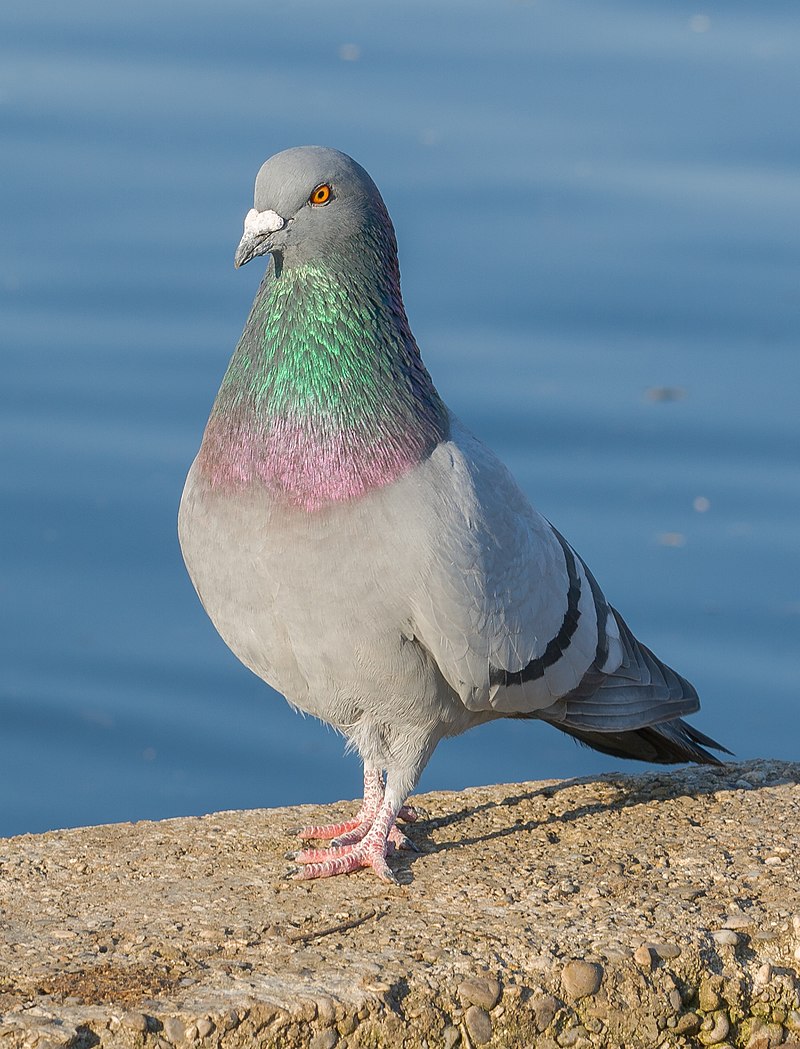
Rock dove, also known as Rock Pigeon or Common Pigeon, is a member of the bird family Columbidae.
It is considered to be an important creature worldwide due to its domestication by humans centuries ago; resulting in the modern-day Domestic pigeon which descends from this species.
Its population has increased over time because some domestic pigeons have escaped captivity and joined wild populations.
The rock dove can most easily be identified by its prominent blue-grey feathers with darker bars on wings and tail along with two black bands on each wing.
They are typically found in large flocks near cliffs or buildings but may also inhabit rural habitats such as open fields and meadows if there’s enough food available for them nearby.
Although they don’t migrate far distances like other birds, their numbers increase significantly during winter months.
When more food sources become available closeby so that they won’t need to travel too far away from home base for nourishment.Scientific classification:
| Kingdom | Animalia |
| Phylum | Chordata |
| Class | Aves |
| Order | Columbiformes |
| Family | Columbidae |
| Genus | Columba |
| Species | C. livia |
Also Featured In: Common Birds in India, Italian Birds You Should Know
2. Rose-Ringed Parakeet
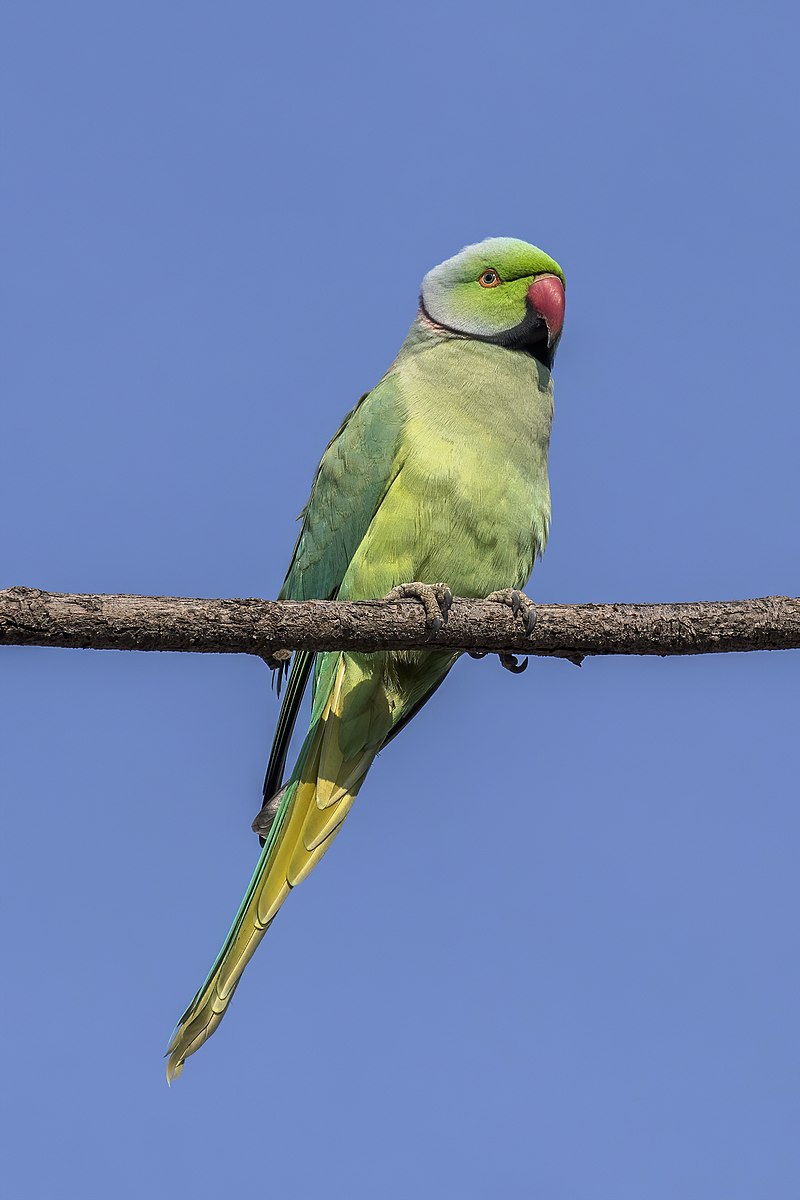
The Rose-ringed parakeet is a medium sized bird in the family Psittacidae. Native to Africa and India, it has been introduced into many other parts of the world where feral populations have now established themselves.
The most distinctive feature of this species is its colorful neck ring ranging from pink to purple which gives them their name.
However, males often display more vibrant colors than females do. This beautiful bird can also imitate human speech quite well making them popular pets worldwide.
In addition they are very social creatures preferring large flocks when out in nature or as part of aviaries during captivity. With proper care these birds can live up to 30 years.Scientific classification:
| Kingdom | Animalia |
| Phylum | Chordata |
| Class | Aves |
| Order | Psittaciformes |
| Family | Psittaculidae |
| Genus | Psittacula |
| Species | P. krameri |
Also Featured In: Common Birds of Mumbai, Common Birds in London
3. Common Kingfisher
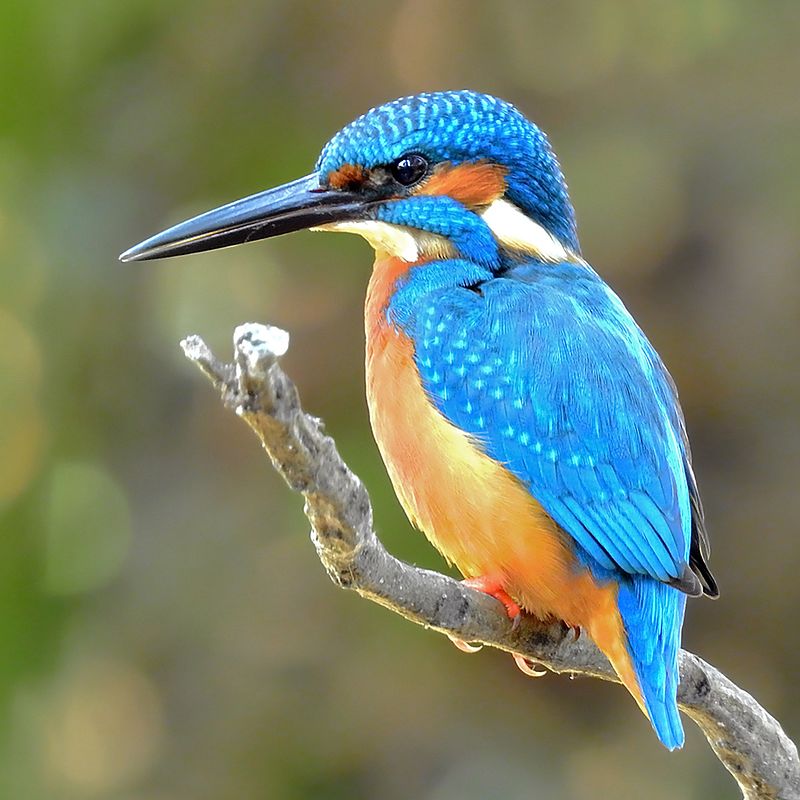
The Common Kingfisher is a small, sparrow-sized bird that can be found across Eurasia and North Africa. It has the typical short tail and large head of kingfishers with seven different subspecies recognized in its range.
They are mainly resident birds but will migrate away during winter when rivers freeze over. The species usually live near bodies of water such as streams or lakes.
Where they hunt for fish by diving from above into the water after spotting their prey below them.
These brightly coloured birds have an unmistakable vibrant blue plumage along with orange underparts and white patches on their wings which makes them easy to recognize amongst other similar looking species.
Their call is loud and shrill making it one of the most recognizable sounds heard around wetlands throughout Europe.Scientific classification:
| Kingdom | Animalia |
| Phylum | Chordata |
| Class | Aves |
| Order | Coraciiformes |
| Family | Alcedinidae |
| Subfamily | Alcedininae |
| Genus | Alcedo |
| Species | A. atthis |
Also Featured In: Most Common Romanian Birds, Birds Found in Hungary
4. Black Kite
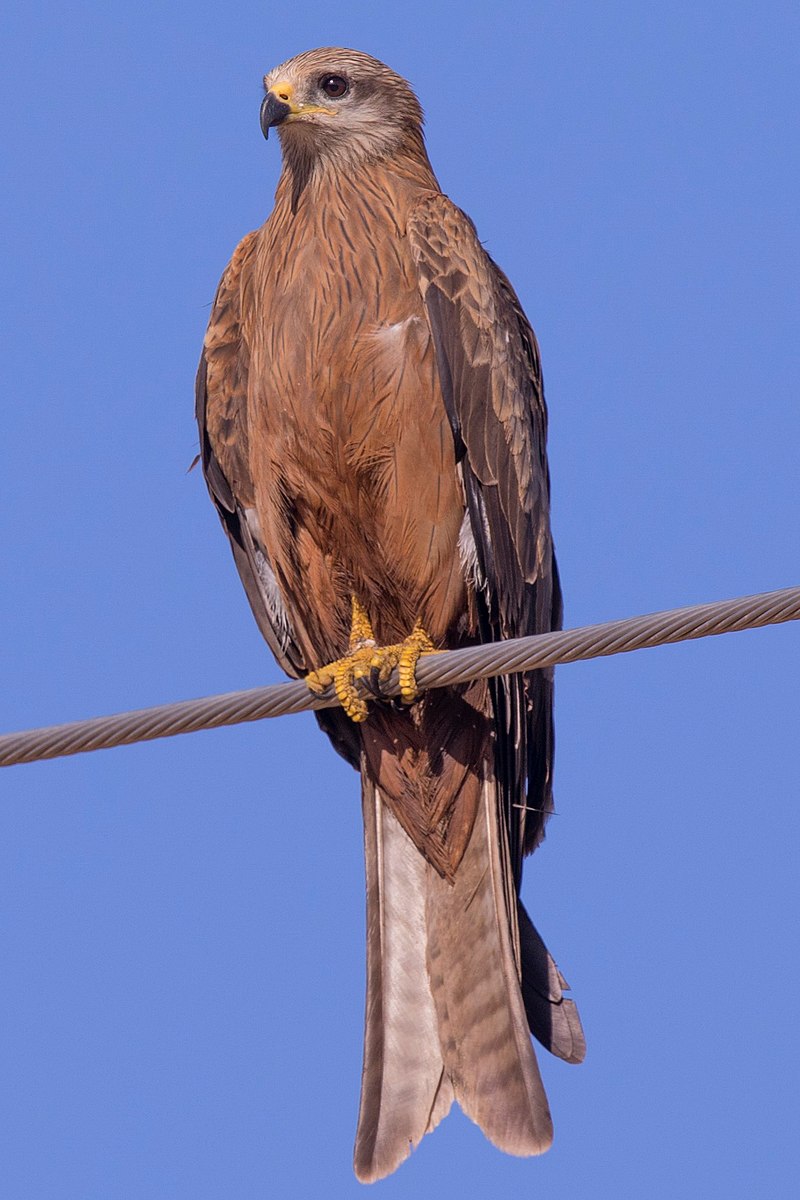
The black kite is one of the most abundant species of diurnal birds of prey in the world, with a global population estimated to be up to 6 million individuals.
It belongs to the family Accipitridae and has medium-sized body size. The wingspan can range from 150 cm – 180cm wide.
They have dark brown feathers on their back and light brown or grey underparts and long forked tails that help it maneuver through.
Its environment while hunting for food like insects, small mammals, reptiles etc., along with scavenging opportunities when available.
Black Kites are found across several continents including Europe, Africa, Asia Minor & Australia where they breed during spring in nests made among trees near wetlands or riversides;
migratory populations move southward away from winter cold temperatures as far east as India & Japan before returning home again next season.Scientific classification:
| Kingdom | Animalia |
| Phylum | Chordata |
| Class | Aves |
| Order | Accipitriformes |
| Family | Accipitridae |
| Genus | Milvus |
| Species | M. migrans |
Also Featured In: Summer Birds that Live around Us, Hong Kong Birds You Need to See
5. American Robin

The American robin is a migratory bird, belonging to the true thrush genus and Turdidae family.
It was named after its European counterpart due to the similar reddish-orange breast they both possess; however, they are not related closely.
This species can be seen through most of North America during winter months, as well as in parts of Mexico and Central America where it also breeds.
They have plump bodies with gray upperparts and white underparts that vary from yellow on their throats down to orange toward their bellies.
Robins feed on fruits such as berries or insects like worms which makes them an important part of ecosystems by helping disperse seeds naturally throughout these areas.Scientific classification:
| Kingdom | Animalia |
| Phylum | Chordata |
| Class | Aves |
| Order | Passeriformes |
| Family | Turdidae |
| Genus | Turdus |
| Species | T. migratorius |
Also Featured In: Most Common United States Birds, Most Common Songs Birds that Live around You
6. Songbirds
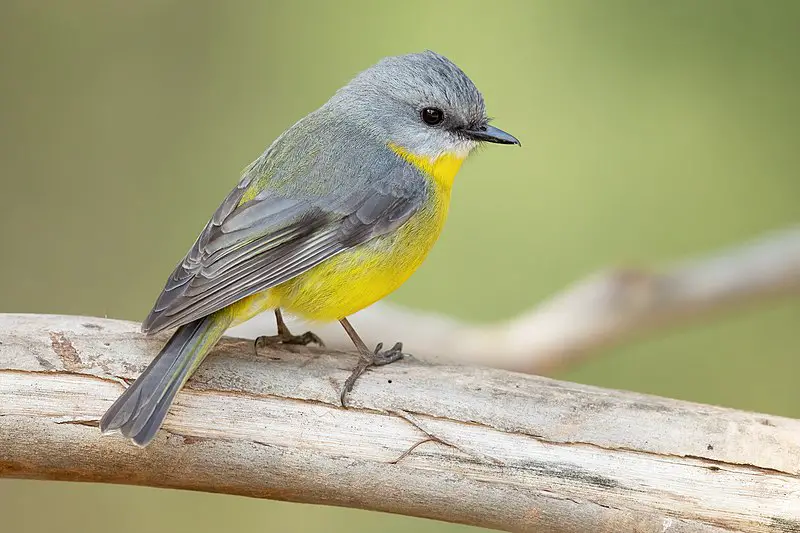
Songbirds are a special suborder of perching birds found all over the world. These beautiful creatures have intricate vocal organs that allow them to produce elaborate bird songs, making them stand out from other species.
With around 5,000 different types of songbird in existence, they come in various sizes and colors with complex feathers adding to their beauty.
Songbirds play an important role in eco-systems as they help disperse seeds by eating fruit and insects which act as agents for pollination.
Their presence also serves to attract more biodiversity into areas where these delicate animals live, creating vibrant habitats full of life.Scientific classification:
| Kingdom | Animalia |
| Phylum | Chordata |
| Class | Aves |
| Order | Passeriformes |
| Clade | Eupasseres |
| Suborder | Passeri Linnaeus, 1758 |
Also Featured In: Famous Paintings Birds, Blue Birds You’ll Found around Us
7. Black-Capped Chickadee

The black-capped chickadee is a small and cheerful songbird found in deciduous and mixed forests across North America. It has an iconic black cap, white cheeks, gray back and wings with whitish bars on them.
The underparts are usually light colored or greyish brown. This species is well adapted to cold winters as it can reduce its body temperature by up to 8°C while roosting at night; this helps save energy during the colder months of the year.
It feeds mainly on insects but also eats seeds, fruits and suet from bird feeders when available.
Black-capped chickadees are popular birds among backyard visitors due to their sociable nature – they often establish lifelong partnerships with one another for breeding purposes.
Furthermore, they have been designated as state birds of Massachusetts and Maine in USA plus New Brunswick in Canada – a testament to how beloved these little avian friends truly are.Scientific classification:
| Kingdom | Animalia |
| Phylum | Chordata |
| Class | Aves |
| Order | Passeriformes |
| Family | Paridae |
| Genus | Poecile |
| Species | P. atricapillus |
Also Featured In: New Hampshire Birds You Should Know, Autumn Birds You Should Know
8. Wrens
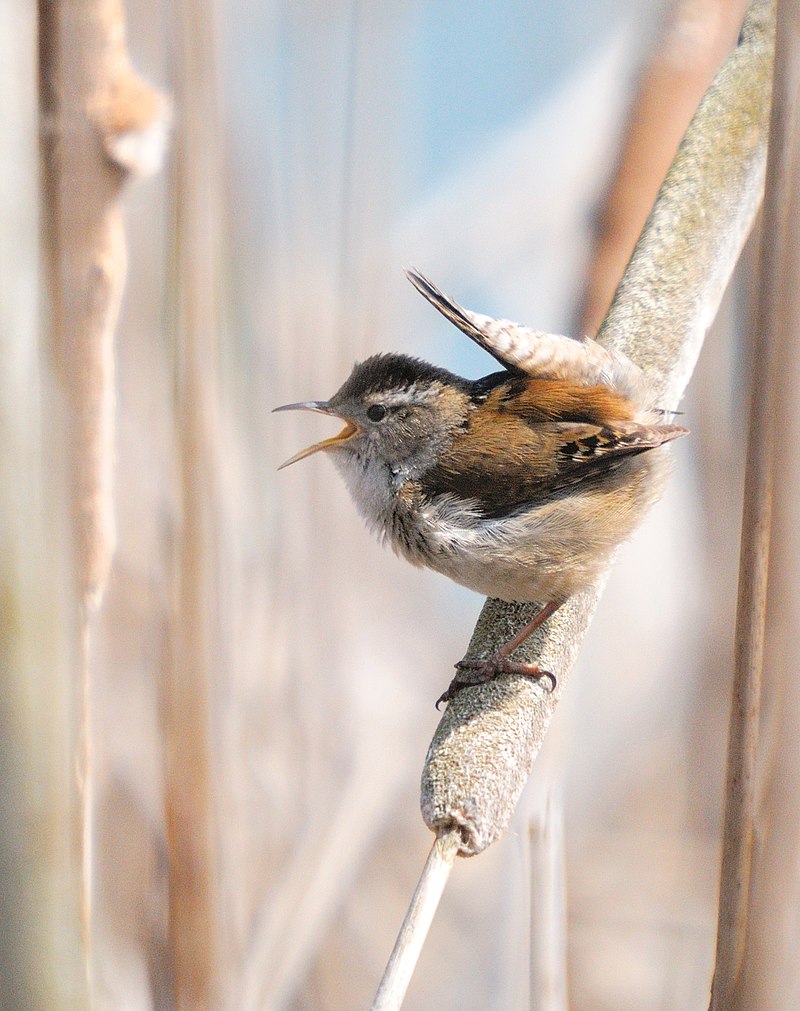
Wrens are a family of small brown passerine birds found mainly in the Americas. They are considered one of the most abundant bird species, with 88 known varieties divided into 19 genera.
The Eurasian wren is the only type that inhabits Europe and other parts of the Old World, where it’s commonly referred to simply as “wren.”
This species has been given its name due to similar-looking unrelated birds living elsewhere such as New Zealand wrasses.
Wrens have tiny bodies with thin bills and long tails which they often hold upright for hours at a time while singing their loud cheery songs from treetops or low shrubs.
Their diet consists mostly of insects but can also include fruits and seeds depending on availability in their habitat range.Scientific classification:
| Kingdom | Animalia |
| Phylum | Chordata |
| Class | Aves |
| Order | Passeriformes |
| Superfamily | Certhioidea |
| Family | Troglodytidae Swainson, 1832 |
Also Featured In: Common Denmark Birds, Most Common Scotland Birds
9. Peregrine Falcon
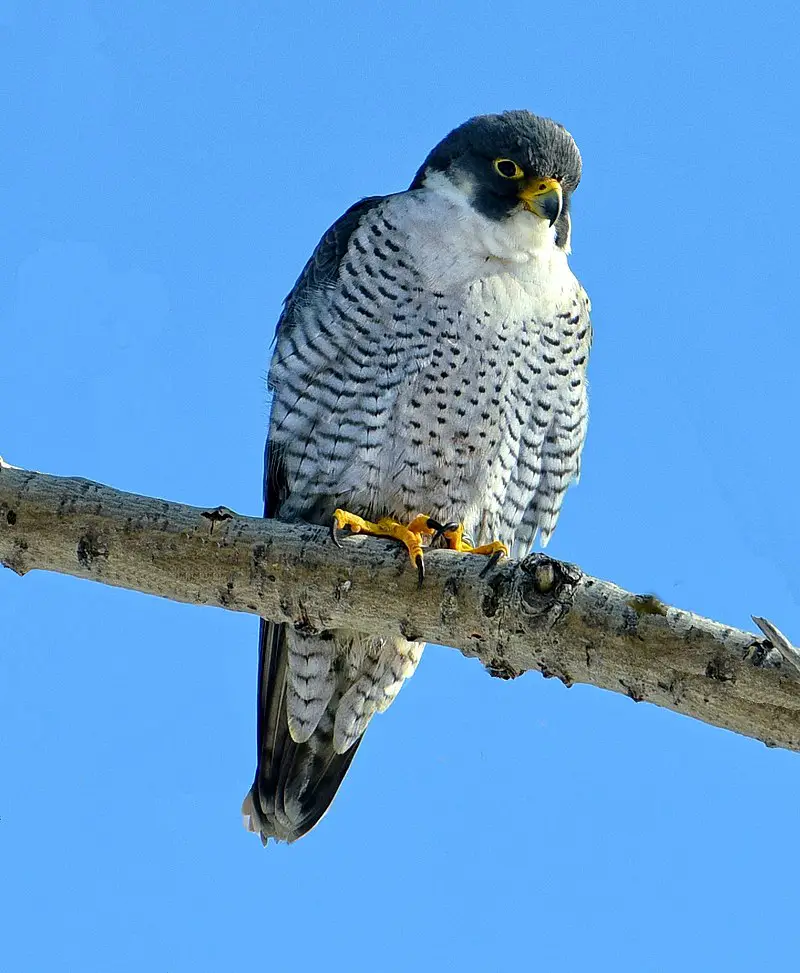
The Peregrine Falcon is a majestic bird of prey belonging to the family Falconidae. It has a blue-grey back, barred white underparts and black head making it easily recognizable.
This intelligent raptor is known for its incredible speed reaching over 320 km/h (200 mph) during hunting dives – one of the fastest animals in existence.
The peregrine falcon can be found around the world from Arctic tundra to tropical rainforests thriving with humans or in high alpine mountains far away from civilization.
With their beauty, power and adaptability they are an impressive species that have earned respect among many cultures throughout history as symbols of strength and endurance.Scientific classification:
| Kingdom | Animalia |
| Phylum | Chordata |
| Class | Aves |
| Order | Falconiformes |
| Family | Falconidae |
| Genus | Falco |
| Species | F. peregrinus |
Also Featured In: Birds of Sweden, Birds that Live in the Deserts
10. House Sparrow

The house sparrow is a small bird of the Passeridae family. It has an average length of 16 cm and weighs 24-39.5 gm.
Females have dull brown and grey plumage, whereas males are brighter, with black, white and brown markings on their wings and back feathers.
This species is one among 25 different kinds in its genus Passer .These birds are found all around the world mainly near human dwellings where they feed off food scraps from garbage bins or gardens etc..
They also make nests close to houses which makes them even more visible to people living nearby.
House sparrows can be seen hopping around yards looking for food during daytime hours but usually hide in colonies at night time.Scientific classification:
| Kingdom | Animalia |
| Phylum | Chordata |
| Class | Aves |
| Order | Passeriformes |
| Family | Passeridae |
| Genus | Passer |
| Species | P. domesticus |
Also Featured In: Birds for Your Home Garden, Birds Live in Arkansas
11. House Finch

The House Finch is a species of finch native to western North America and has been introduced in the eastern half of the continent as well as Hawaii.
It’s an average-sized finch with adults measuring 12.5 – 15 cm (5 – 6 inches) long and having wingspans between 20 – 25 cm (8 – 10 inches).
The upperparts are brown, while its underparts range from pale grayish white to yellow depending on subspecies.
Its face is streaked or spotted with reddish coloration; males typically have brighter plumage than females due to sexual dimorphism.
They’re mostly found near human habitations such as farms and gardens where they feed on grains, fruits, insects etc., making them very popular among birders who want something colorful for their backyard.Scientific classification:
| Kingdom | Animalia |
| Phylum | Chordata |
| Class | Aves |
| Order | Passeriformes |
| Family | Fringillidae |
| Subfamily | Carduelinae |
| Genus | Haemorhous |
| Species | H. mexicanus |
Also Featured In: Birds Live Near San Diego, Common Birds That Live in Las Vegas
12. Common Starling

The Common Starling is a medium-sized passerine bird that belongs to the starling family. It has glossy black plumage with a metallic sheen, and in certain times of year it can be speckled with white.
The bill and legs are typically pink or black depending on the season, while its length measures about 8 inches long.
Its diet consists mainly of insects but also includes small fruits and seeds as well as some human food waste.
They live in large flocks which provides protection against predators, although they can become quite aggressive when defending their nesting sites during breeding seasons.
Overall, this species is highly adaptable and widely distributed across many parts of Europe making them one of the most successful birds in the region today.Scientific classification:
| Kingdom | Animalia |
| Phylum | Chordata |
| Class | Aves |
| Order | Passeriformes |
| Family | Sturnidae |
| Genus | Sturnus |
| Species | S. vulgaris |
Also Featured In: British Columbian Birds, Birds that Migrate through Illinois in the Spring
13. Mallard
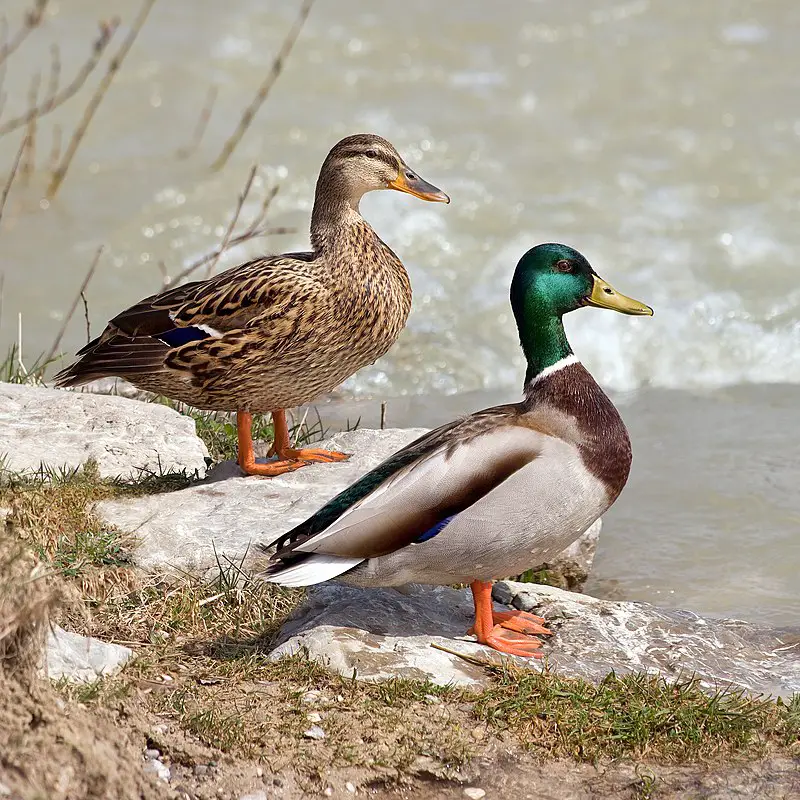
The Mallard is a species of dabbling duck that can be found living in temperate and subtropical regions across the Americas, Eurasia and North Africa.
It has been introduced to other areas such as New Zealand, Australia, Peru, Brazil and South Africa by humans.
This beautiful bird belongs to the Anatinae subfamily of waterfowl family Anatidae. The adult mallards have a glossy green head with white neck ring surrounding.
It along with brownish grey body feathers making them look stunning when they fly away or just sitting in their natural habitat around lakes or ponds.
They are excellent swimmers too due to webbed feet which helps them swim fast underwater while looking for food like aquatic insects etc.. Their loud quacking sound makes them quite popular among nature lovers.Scientific classification:
| Kingdom | Animalia |
| Phylum | Chordata |
| Class | Aves |
| Order | Anseriformes |
| Family | Anatidae |
| Genus | Anas |
| Species | A. platyrhynchos |
Also Featured In: Most Popular Bird Species in North America, Water Birds Live around Us
14. Barn Swallow
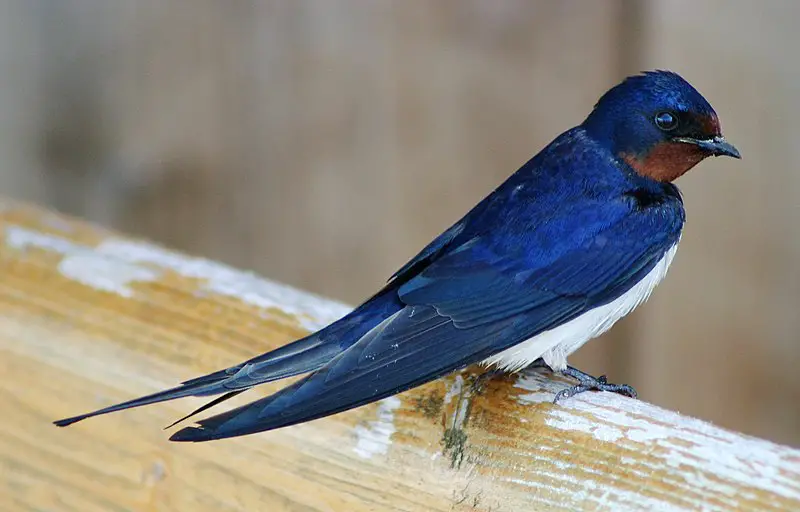
The Barn Swallow is a beautiful passerine bird with blue upperparts and a long, deeply forked tail. Found in Europe, Asia, Africa and the Americas.
It has an astonishingly large natural distribution spanning 251 million square kilometres globally; likely making it one of the world’s most widespread species.
This swallow typically nests near human habitation as well as other open areas such as fields or grasslands which provide them with suitable invertebrate prey to feed on.
They are insectivorous birds that often fly together in flocks looking for food over rivers or marshes usually just above tree-top level.
The barn swallow can also be identified by its strong flight consisting of swift continuous wing beats interspersed with glides during which they hold their wings slightly raised at the shoulders giving them distinct V shaped silhouettes in the sky.Scientific classification:
| Kingdom | Animalia |
| Phylum | Chordata |
| Class | Aves |
| Order | Passeriformes |
| Family | Hirundinidae |
| Genus | Hirundo |
| Species | H. rustica |
Also Featured In: Birds that Live in Croatia, Flight Birds You Should Know
15. Common Myna
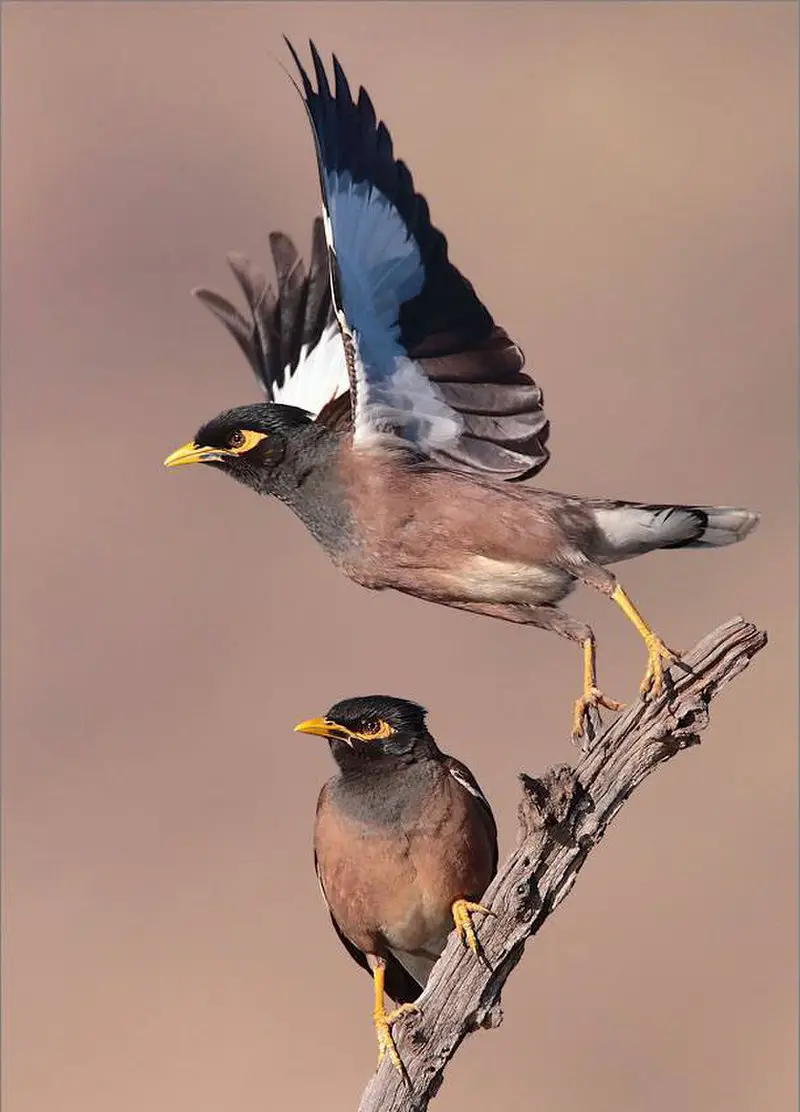
The Common myna is a bird native to Asia and belongs to the Sturnidae family. It has an omnivorous diet, strong territorial instinct and is well adapted to urban environments.
With its range increasing rapidly, it was declared one of the most invasive species by IUCN in 2000. Its distinctive features include black head with a yellow bill, brown body and white tips on wings & tail feathers.
The common myna communicates through loud clicking noises that can easily be heard from long distances in both rural as well as urban areas alike.
They are known for their intelligence; they mimic sounds such as human speech or other birds’ calls making them popular pets among households too.Scientific classification:
| Kingdom | Animalia |
| Phylum | Chordata |
| Class | Aves |
| Order | Passeriformes |
| Family | Sturnidae |
| Genus | Acridotheres |
| Species | A. tristis |
Also Featured In: Most Common Types of Bangladeshi Birds, Birds of Kauai, Hawaii
16. Eurasian Collared Dove
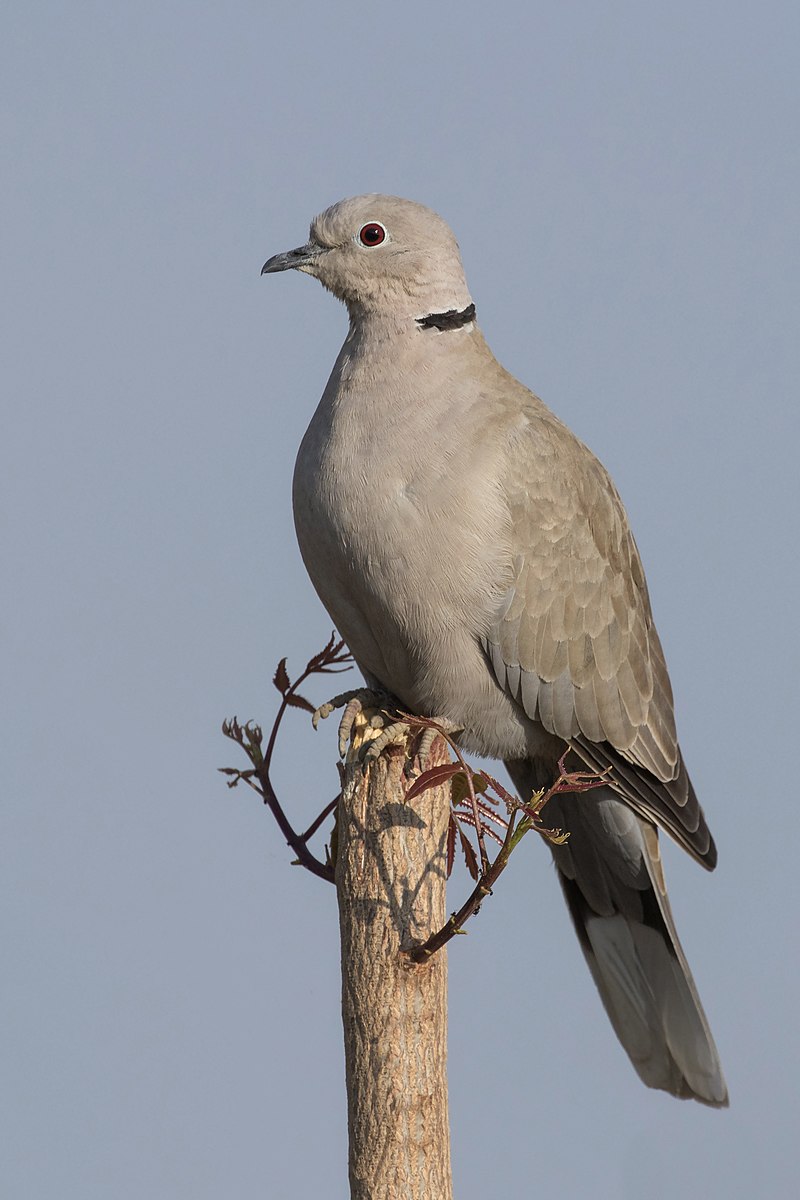
The Eurasian collared dove is a species of bird native to Europe and Asia, with its range expanding through introduction in Japan, North America, and islands in the Caribbean.
It has become so widespread that it is listed as Least Concern on the IUCN Red List. The scientific name for this bird was proposed by Hungarian naturalist Imre Frivaldsz – Columba decaocto.
This beautiful creature typically measures between 33-37 cm from tip to tail feathers, displaying an overall greyish brown plumage; they also have distinctive black half collar around their neck which gives them their common name.
These birds are mainly found inhabiting open woodlands or agricultural lands near human settlements where there’s plenty of food available such as grain fields or gardens where fruits can be eaten off trees.
With a vast global population trend increasing steadily each year these birds make great additions to many backyards throughout the world.Scientific classification:
| Kingdom | Animalia |
| Phylum | Chordata |
| Class | Aves |
| Order | Columbiformes |
| Family | Columbidae |
| Genus | Streptopelia |
| Species | S. decaocto |
Also Featured In: Top Birds Found in Mexico, Turkey Birds You Should Know
17. Crow Family
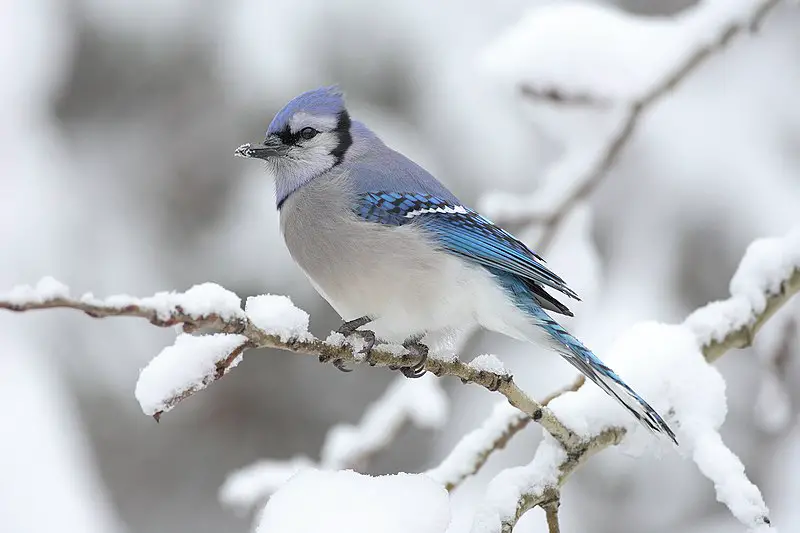
The Crow family is a cosmopolitan group of birds that contains crows, ravens, rooks, jackdaws, jays, magpies and more.
Altogether there are 133 members in this bird family which all share similar characteristics such as large beaks and feet.
The genus Corvus alone makes up over a third of the entire crow family population with species like the common crow or blackbird being some of its most recognizable members.
All these birds have strong social bonds so they often travel in groups to find food sources or build nests together for protection against predators.
With their intelligence and adaptation skills they are able to survive almost anywhere on Earth from mountains to cities making them one of the world’s most successful families of avian creaturesScientific classification:
| Kingdom | Animalia |
| Phylum | Chordata |
| Class | Aves |
| Order | Passeriformes |
| Superfamily | Corvoidea |
| Family | Corvidae Leach, 1820 |
Also Featured In: Common Birds in Japan, Birds of Latvia
18. Japanese Bush Warbler
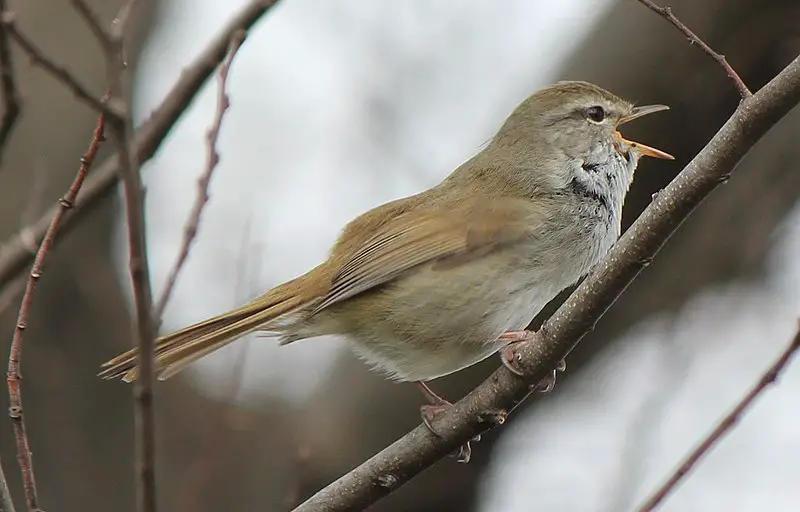
The Japanese bush warbler is a small passerine bird that can often be heard, but rarely seen. It has an olive brown colour with dusky shades below and its distinct pale eyebrows give it an almost smiling look due to the curved shape of its beak.
During springtime, these birds are known for their sweet singing which can be heard throughout Japan.
They typically inhabit areas such as deciduous forests, parks or gardens near human habitations in order to find food and suitable nesting places in trees or shrubs.
The diet consists mainly of insects like grasshoppers, cicadas and beetles as well as some fruits during autumn season when they prepare for migration southwards to warmer climates before winter arrives.Scientific classification:
| Kingdom | Animalia |
| Phylum | Chordata |
| Class | Aves |
| Order | Passeriformes |
| Family | Cettiidae |
| Genus | Horornis |
| Species | H. diphone |
Also Featured In: White Oahu Birds, White Birds Commonly Found in Hawaii
19. White Wagtail
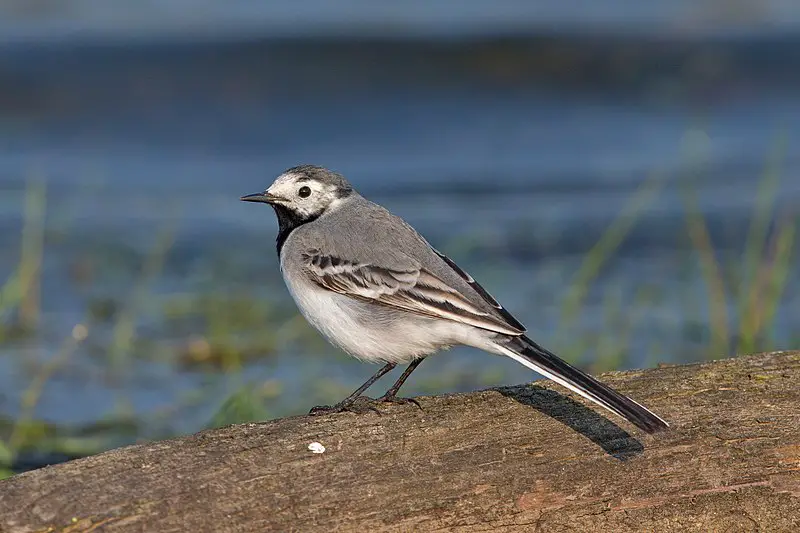
The White Wagtail is a small passerine bird that belongs to the Motacillidae family, which includes pipits and longclaws. This species breeds in Europe, Asia Palearctic and North Africa.
It has also been seen as a scarce breeder in Alaska. Those living in mild climates are found year-round but others migrate south for winter months to Africa.
In Ireland and Great Britain it’s known for its darker subspecies called Pied Wagtails with their distinctive white heads, grey backs and yellow breasts.
They feed on insects such as flies, beetles or spiders by wagging their tail up & down while they walk along surfaces like tree trunks or walls looking out for prey – hence receiving this name.
To attract mates they sing melodic songs from high perches too.Scientific classification:
| Kingdom | Animalia |
| Phylum | Chordata |
| Class | Aves |
| Order | Passeriformes |
| Family | Motacillidae |
| Genus | Motacilla |
| Species | M. alba |
Also Featured In: Egyptian Birds, Common Slovakian Birds
20. Common Swift
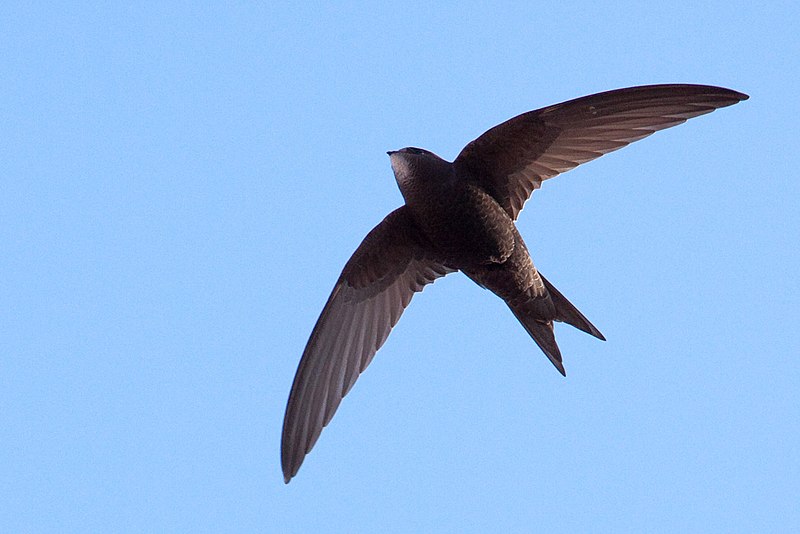
The Common swift is a medium-sized bird with an appearance similar to the barn swallow or house martin.
Its wings are larger, however it is not related to these species but instead belongs in its own order of Apodiformes.
The similarities between the two groups have come about due to convergent evolution and a shared environment.
As for relatives, they can be found among New World hummingbirds and South American swifts; whereas more distant cousins include nightjars as well as treeswifts from Asia/Africa and Australian swiftspecies.
These birds live up high in the air where they remain on constant flight even when sleeping or eating.
They usually migrate south during winter months then return again each springtime bringing life back into our skies.Scientific classification:
| Kingdom | Animalia |
| Phylum | Chordata |
| Class | Aves |
| Order | Apodiformes |
| Family | Apodidae |
| Genus | Apus |
| Species | A. apus |
Also Featured In: Native Birds Of Germany, Birds that Live in Montenegro
21. Northern Goshawk
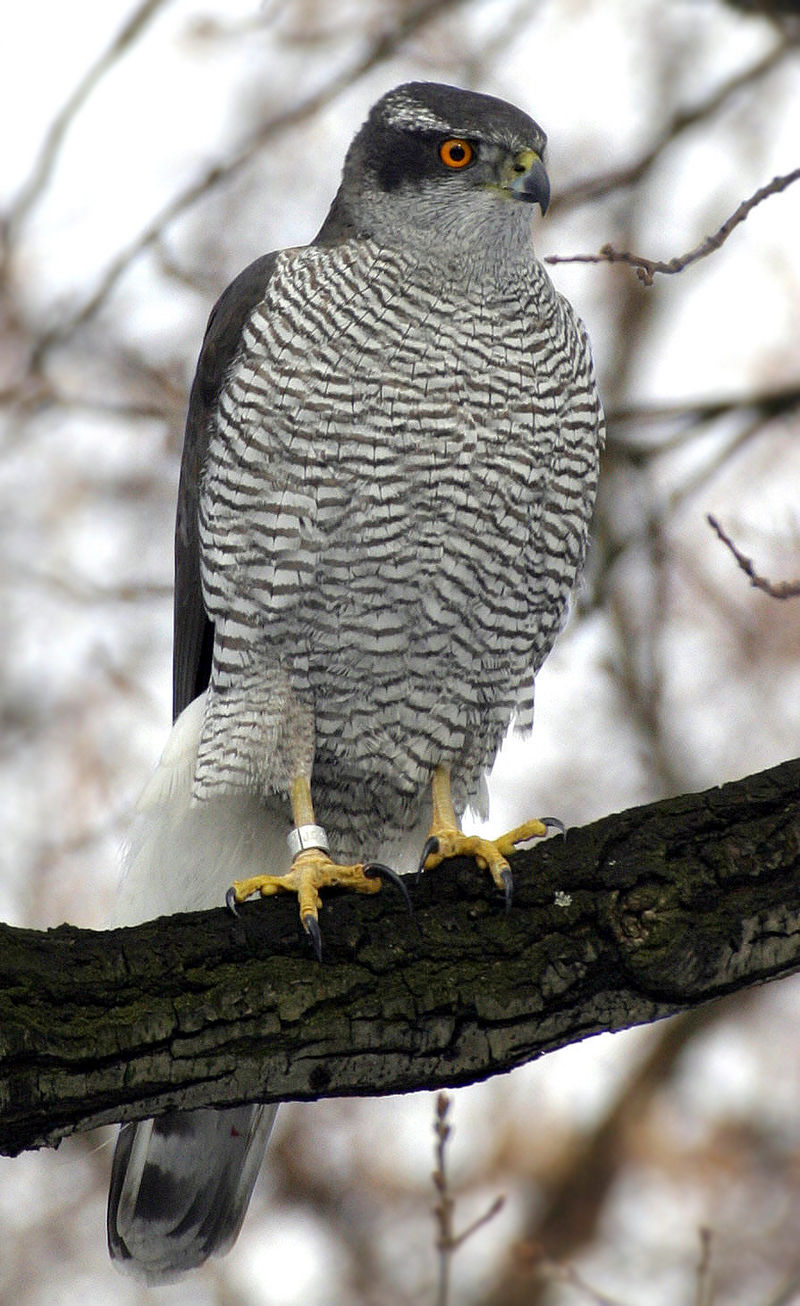
The Northern Goshawk is a medium-large bird of prey belonging to the Accipitridae family. It has been known as one of the true hawks, with “Accipiter” meaning hawk in Latin and “gentilis” referring to its noble characteristics.
They are found worldwide, most commonly in wooded areas such as forests or thickets where they hunt small birds and mammals.
The males have spotted grey upperparts while females tend to be fully brown above with some lighter barring on their underparts.
These raptors rely heavily on speed and agility when hunting from either perches or during aerial dives at high speeds for their prey which makes them formidable predators that can reach up to 40 mph.Scientific classification:
| Kingdom | Animalia |
| Phylum | Chordata |
| Class | Aves |
| Order | Accipitriformes |
| Family | Accipitridae |
| Genus | Accipiter |
| Species | A. gentilis |
Also Featured In: Belarus Birds You Should Know, Most Common Lithuanian Birds
22. Common Blackbird
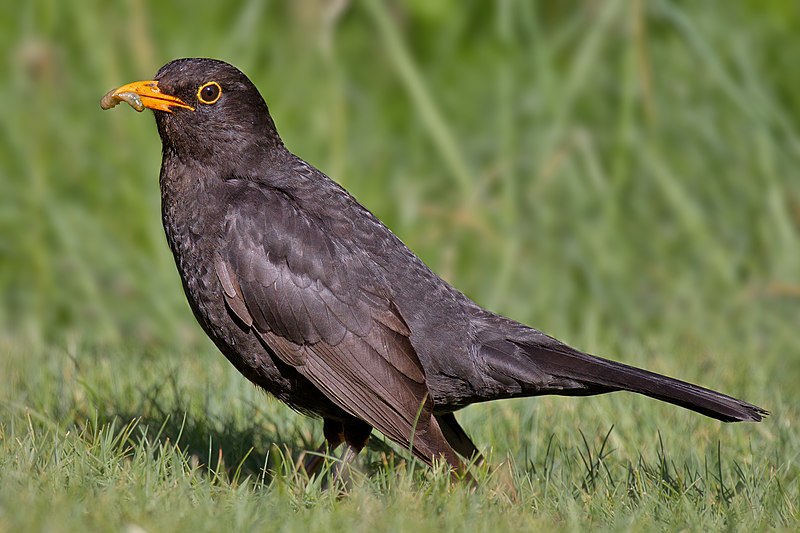
The Common Blackbird is a species of true thrush with the scientific name Turdus merula. Found in Europe, Asiatic Russia and North Africa it has also been introduced to Australia and New Zealand.
The male bird has glossy black plumage while the female’s coloration is more brownish gray.
It is known for its melodious song that can be heard throughout much of the year; typically they are seen alone or in pairs but occasionally form large flocks when food sources become available or during migration periods.
Its diet consists mainly of insects, worms, berries and other fruits as well as some human-provided foods such as bread crumbs or garbage scraps when available.
With its wide distribution range along with ease of adaptation to different habitats this species will likely remain one our most common birds around us.Scientific classification:
| Kingdom | Animalia |
| Phylum | Chordata |
| Class | Aves |
| Order | Passeriformes |
| Family | Turdidae |
| Genus | Turdus |
| Species | T. merula |
Also Featured In: Birds of United Kingdom, Most Common Nature Birds
23. Eurasian Blue Tit
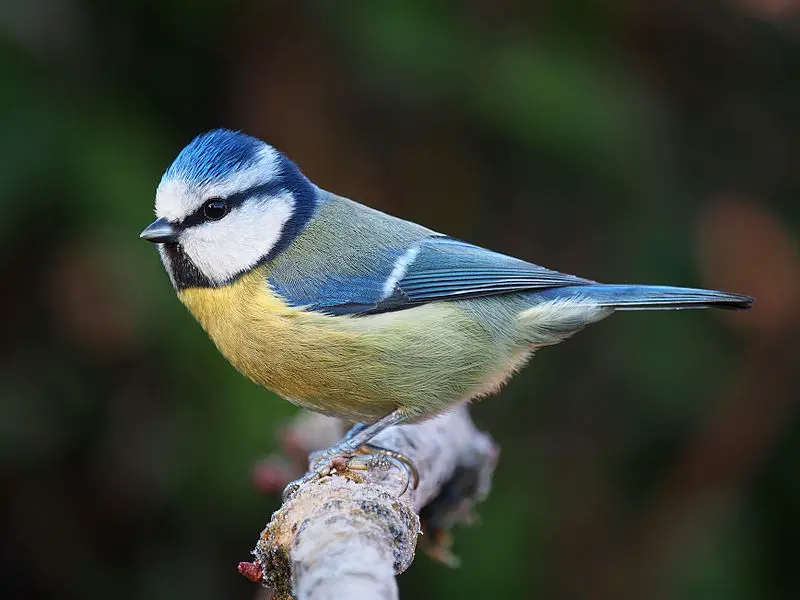
The Eurasian blue tit is a small passerine bird belonging to the Paridae family. Its bright blue and yellow plumage makes it easily recognizable, along with its small size.
They are usually resident birds that do not migrate, living throughout temperate or subarctic Europe and western Palearctic in deciduous woodlands.
These birds breed year-round and are common residents of these areas.
Their diet consists mainly of insects but they also feed on seeds during winter months when insects become scarce.
They can be found both alone or in pairs searching for food amongst trees branches, shrubs, grasses as well as visiting gardens for supplementary food sources such as peanut feeders provided by garden owners.Scientific classification:
| Kingdom | Animalia |
| Phylum | Chordata |
| Class | Aves |
| Order | Passeriformes |
| Family | Paridae |
| Genus | Cyanistes |
| Species | C. caeruleus |
Also Featured In: Fuerteventura Island Birds You Need to See,
24. Great Tit
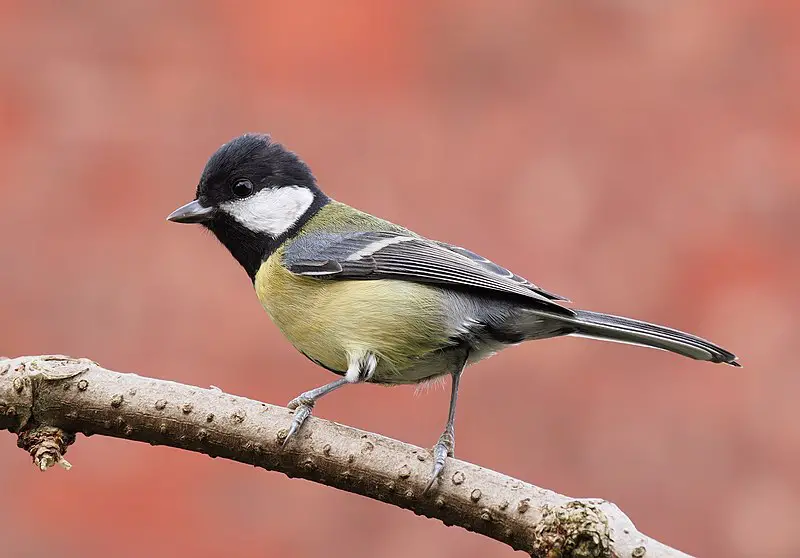
The Great Tit is a small passerine bird found in woodlands throughout Europe, the Middle East and Central Asia. Its beautiful black and white plumage with bold yellow or green patches make it easily distinguishable from other species of its family.
It generally does not migrate except for harsh winters but will stay resident in any kind of woodland area.
The diet consists mainly on insects, seeds and nuts which are found by searching through trees or scavenging from feeders placed near gardens.
Great Tits are also known to be clever problem solvers; they can open milk bottles left out unattended as well as cracking sunflower seeds that provide them essential nutrients during winter months when food is scarce.Scientific classification:
| Kingdom | Animalia |
| Phylum | Chordata |
| Class | Aves |
| Order | Passeriformes |
| Family | Paridae |
| Genus | Parus |
| Species | P. major |
Also Featured In: Amsterdam Birds You Should Know, Spiritual Birds
25. Starling
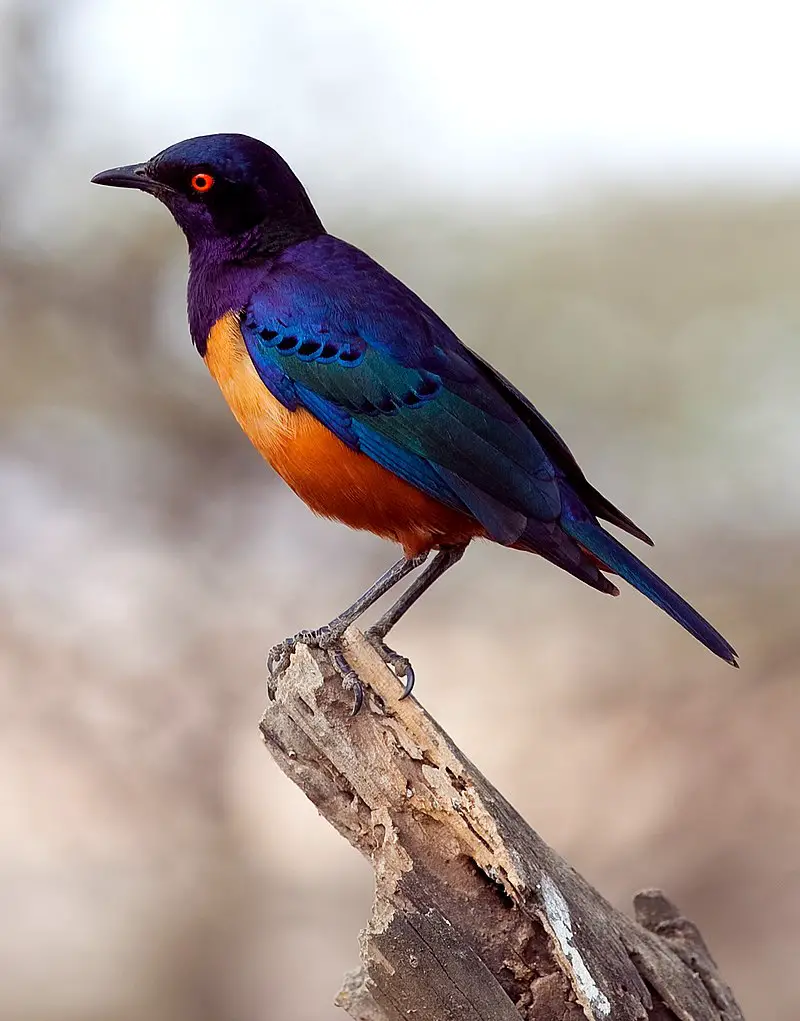
Starlings are small to medium-sized birds belonging to the Sturnidae family. They have a unique iridescent plumage, making them popularly known as glossy starlings in Africa and mynas in Asia.
Starlings inhabit Europe, Asia and Africa; some species even migrate between continents for food or better climates.
These birds form large flocks of up to thousands at a time during their migration periods, creating spectacular visual displays while they soar through the sky.
Besides being beautiful creatures, starlings can also imitate sounds such as human speech – an impressive feat that has been documented by many ornithologists over the years.Scientific classification:
| Kingdom | Animalia |
| Phylum | Chordata |
| Class | Aves |
| Order | Passeriformes |
| Suborder | Passeri |
| Family | Sturnidae Rafinesque, 1815 |
Also Featured In: Birds that Commonly Found in Bali, Common Species of Birds
26. Common Wood Pigeon
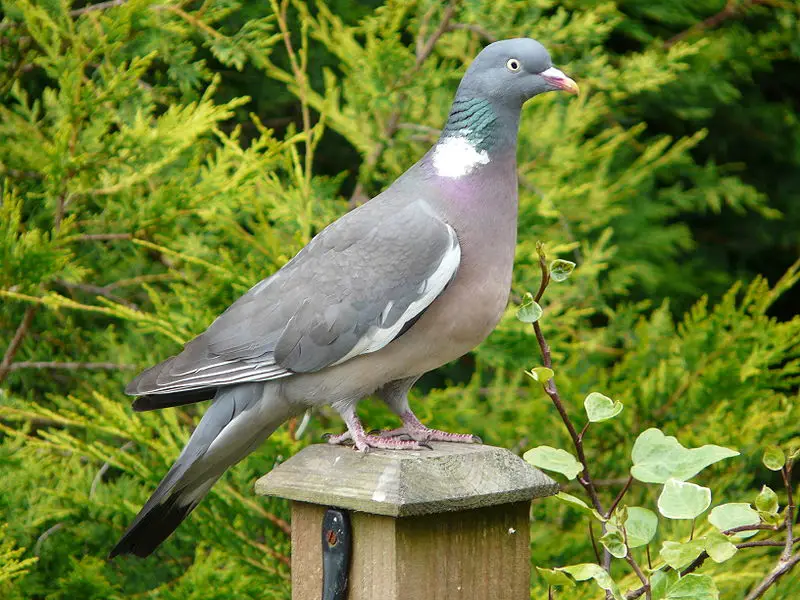
The Common Wood Pigeon is a large bird of the dove and pigeon family, native to the western Palearctic. It has grey plumage with white patches on its wings and neck.
Its head often appears darker than its body due to iridescence in some parts of its feathers. The male woodpigeons have pinkish breasts while females are more brownish-grey coloured.
These birds feed mainly on seeds, fruits, flowers and leaves but will also eat insects when available.
They breed during springtime producing 1-2 clutches per breeding season with two eggs each time which hatch after about 18 days incubation period by both parents taking turns for duty.
They make their nests from twigs collected from nearby trees or places close by and usually raise only one brood at a time making them an important part of nature’s balance as they help keep insect populations under control through their diet choices.Scientific classification:
| Kingdom | Animalia |
| Phylum | Chordata |
| Class | Aves |
| Order | Columbiformes |
| Family | Columbidae |
| Genus | Columba |
| Species | C. palumbus |
Also Featured In: Common Serbian Birds, Birds of Islamabad
27. Carrion Crow
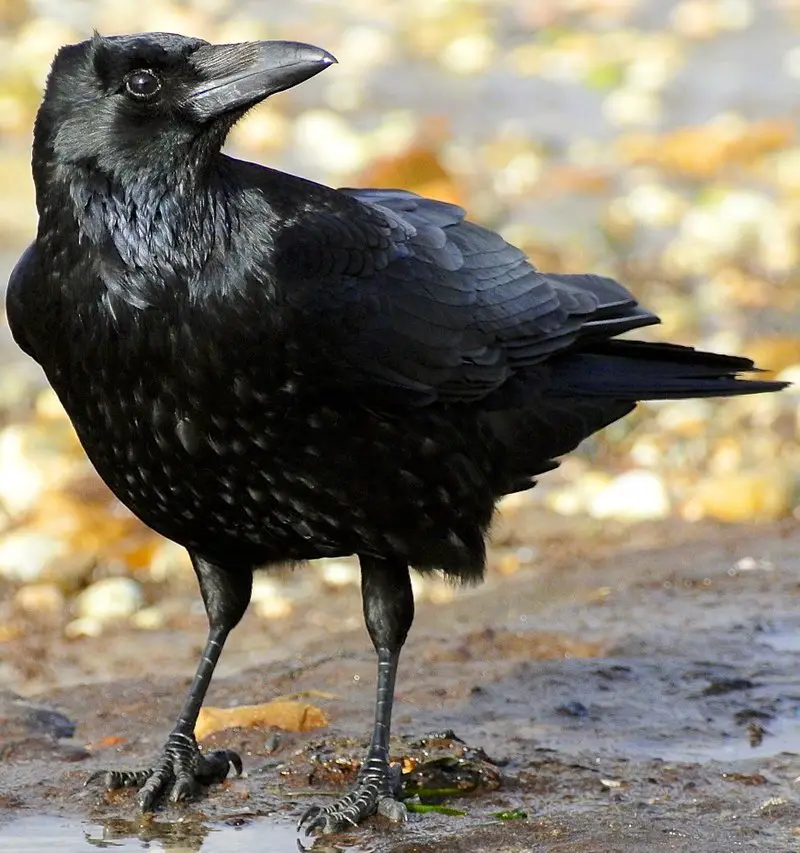
The Carrion Crow is a large, black bird that belongs to the family Corvidae and genus Corvus. Native to western Europe and Eastern Palearctic, it was one of the species described by Carl Linnaeus in his 1758 10th edition of Systema Naturae.
The name comes from Latin words meaning “crow” and “crown”. This crow has an unmistakable appearance; its entire body is covered in glossy black feathers with blue or purple iridescence on its wings when caught in sunlight.
Its diet consists mainly of carrion but they also eat insects, fruits, grains, nuts , eggs and small vertebrates such as young birds.
They are known for their intelligence which allows them to find food more easily than other corvid species due to their ability make tools out sticks or stones like humans do.Scientific classification:
| Kingdom | Animalia |
| Phylum | Chordata |
| Class | Aves |
| Order | Passeriformes |
| Family | Corvidae |
| Genus | Corvus |
| Species | C. corone |
Also Featured In: Scavengers Birds You Should Know,
28. Common Chaffinch

The Common Chaffinch is a beautifully coloured small passerine bird belonging to the finch family.
The males have striking blue-grey caps and rust-red underparts, while the females are more subtle in their colouring but both possess two distinct white wing bars and white sides on their tails.
This gorgeous bird has an incredibly strong voice which can be heard for miles as it sings from exposed perches during mating season.
It lives mainly throughout Europe but also in parts of North Africa and Asia too, favouring woodland areas with plenty of shrubs or trees nearby where they find shelter amongst foliage when needed.
They feed predominantly on seeds from weeds or grains found within grasslands making them particularly useful birds for farmers who rely heavily upon pest control that these little ones provide.Scientific classification:
| Kingdom | Animalia |
| Phylum | Chordata |
| Class | Aves |
| Order | Passeriformes |
| Family | Fringillidae |
| Subfamily | Fringillinae |
| Genus | Fringilla |
| Species | F. coelebs |
Also Featured In: Birds that Calls in the Morning, Common Birds of Portugal
29. European Greenfinch
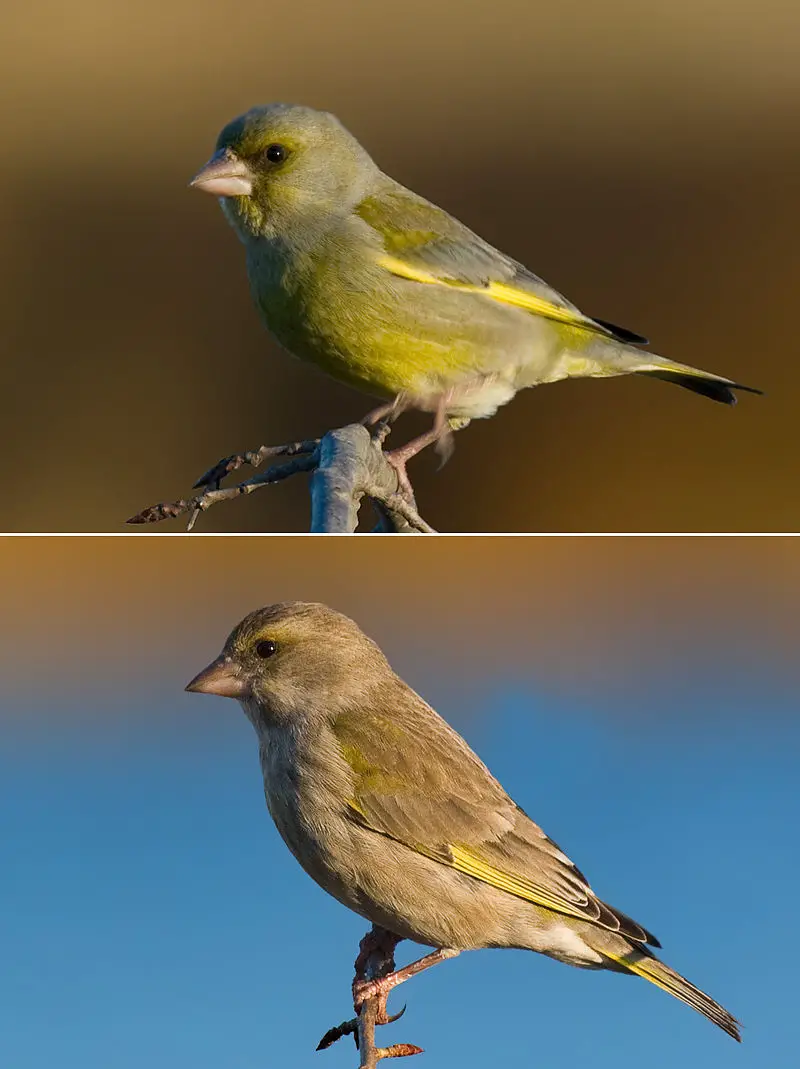
The European Greenfinch is a small, passerine bird from the finch family Fringillidae. It can be found throughout Europe, North Africa and Southwest Asia.
Some of its northernmost populations migrate further south during winter for warmer climates.
The species has been introduced to Australia, New Zealand, Uruguay and Argentina as well with great success in these new environments.
It was first described scientifically by Carl Linnaeus back in 1758 who noted its bright green feathers along with yellow edges on the wings and tail which make it an unmistakable sight when seen up close or at a distance while flying through open grasslands or wooded areas where they are known to feed on insects and seeds alike making them highly adaptable birds that find food sources easily wherever they go.Scientific classification:
| Kingdom | Animalia |
| Phylum | Chordata |
| Class | Aves |
| Order | Passeriformes |
| Family | Fringillidae |
| Subfamily | Carduelinae |
| Genus | Chloris |
| Species | C. chloris |
30. Tit
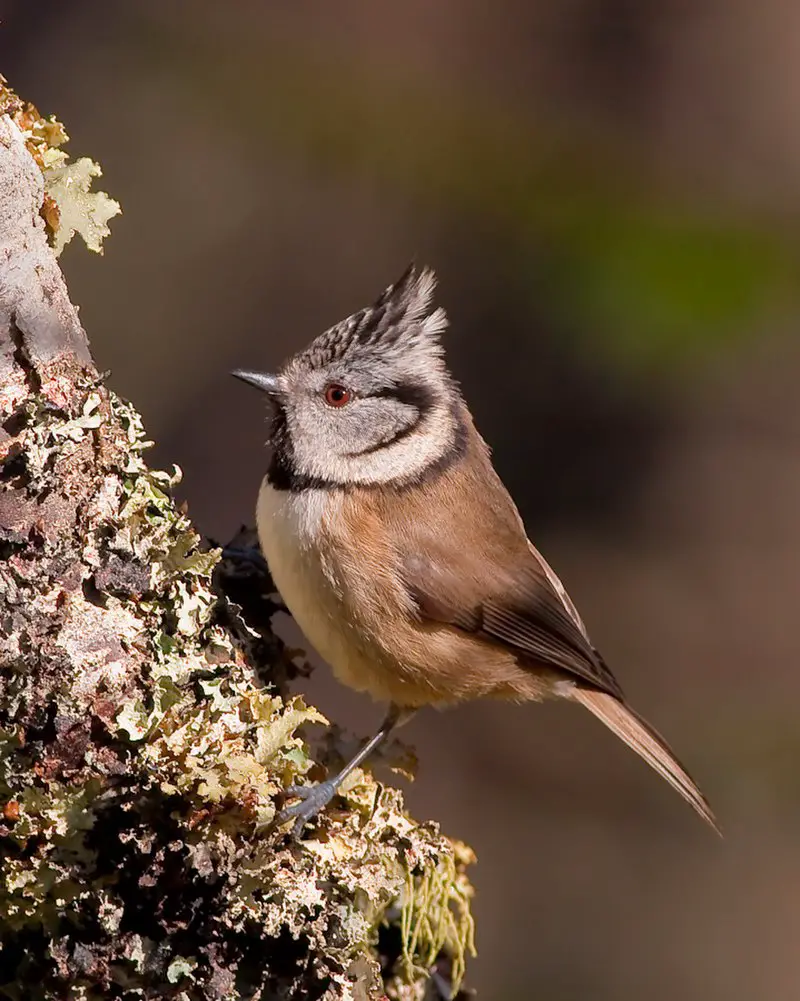
Tit birds are small passerine birds belonging to the family Paridae, found mainly in Northern Hemisphere and Africa.
These active little birds can be seen singing sweet songs throughout the day or scavenging for food at feeders.
They have short, stout bills which they use to crack open seeds and nuts with ease. Tit species range from chickadees to titmice; all of them sport a distinctive black head cap that stands out against their pale grey bodies.
Their bright eyes allow them excellent vision while searching for food – even on gloomy days when other predators may not see as well.
Tits are an important part of any healthy ecosystem and provide many ecological services such as insect control and seed dispersal.Scientific classification:
| Kingdom | Animalia |
| Phylum | Chordata |
| Class | Aves |
| Order | Passeriformes |
| Infraorder | Passerida |
| Family | Paridae Vigors, 1825 |
Also Featured In: Willows Birds Around You, Black And White Birds You Don’t Know About
31. Black Redstart
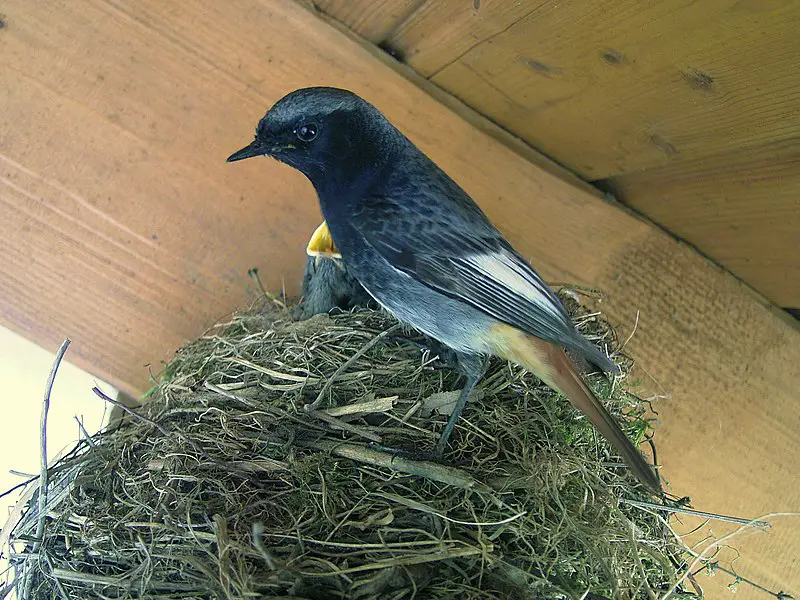
The black redstart is a small passerine bird found in the genus Phoenicurus. It was previously classified as part of the thrush family but now belongs to the Old World flycatcher family.
It has an overall black coloration with striking patches of bright orange or rusty-red on its wings and tail, giving it its name “black redstart”.
The male also sports a prominent crest which he can raise when displaying for females during breeding season.
This species inhabits open woodland areas and generally feeds on insects such as flies, beetles, spiders and caterpillars; although they will supplement their diet with berries where available.
They are often seen perched very prominently from exposed branches near food sources like hedgerows or tree stumps making them easier to spot than some other birds of similar sizeScientific classification:
| Kingdom | Animalia |
| Phylum | Chordata |
| Class | Aves |
| Order | Passeriformes |
| Family | Muscicapidae |
| Genus | Phoenicurus |
| Species | P. ochruros |
Also Featured In: Common Cornwall Birds, Birds That Live in Anglesey
32. Song Thrush
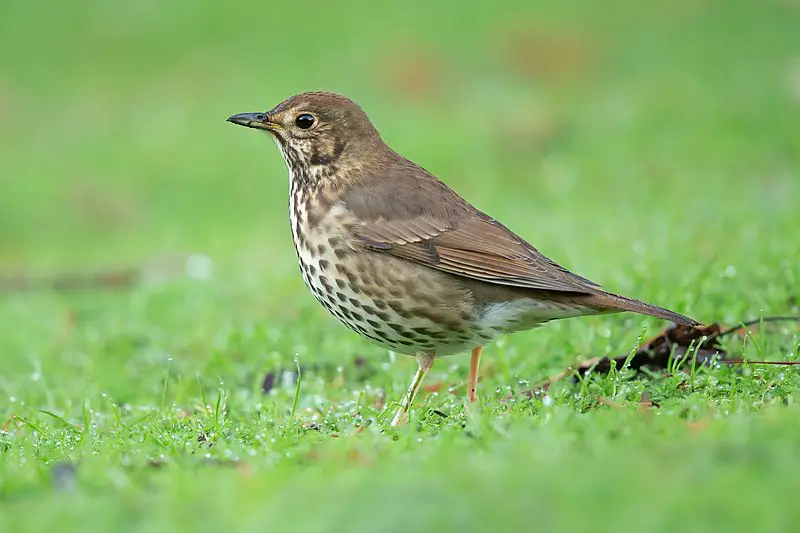
The Song Thrush is a beautiful bird that breeds across the West Palearctic. It has brown upper-parts and creamy or buff underparts with black spots, as well as three recognised subspecies.
Its vocalisations are particularly melodious; its song consists of repeated musical phrases, hence why it has been referenced often in poetry.
This species can be found breeding in forests, gardens and parks during summertime months before migrating elsewhere for winter.
With its attractive plumage and lovely singing voice, it’s no wonder this thrush is so beloved by many.Scientific classification:
| Kingdom | Animalia |
| Phylum | Chordata |
| Class | Aves |
| Order | Passeriformes |
| Family | Turdidae |
| Genus | Turdus |
| Species | T. philomelos |
Also Featured In: Black Birds in New Zealand,
33. Great Egret

The Great Egret is a large, white bird found in many regions of the world. It has four subspecies that reside across Asia, Africa, Americas and southern Europe.
This species usually lives near bodies of water such as lakes and marshes. They are also now starting to spread into more northern areas of Europe due to climate change.
These birds have long yellow legs with an impressive wingspan for their size which allows them to soar majestically through the sky hunting for fish or amphibians in shallow waters below.
Their feathers have been used historically by Native Americans as part of traditional garments or ceremonies but this practice should be avoided today so these amazing creatures can thrive without harm from humans.Scientific classification:
| Kingdom | Animalia |
| Phylum | Chordata |
| Class | Aves |
| Order | Pelecaniformes |
| Family | Ardeidae |
| Genus | Ardea |
| Species | A. alba |
Also Featured In: Most common Birds in France, Most Common Lake Birds
34. Common Kestrel
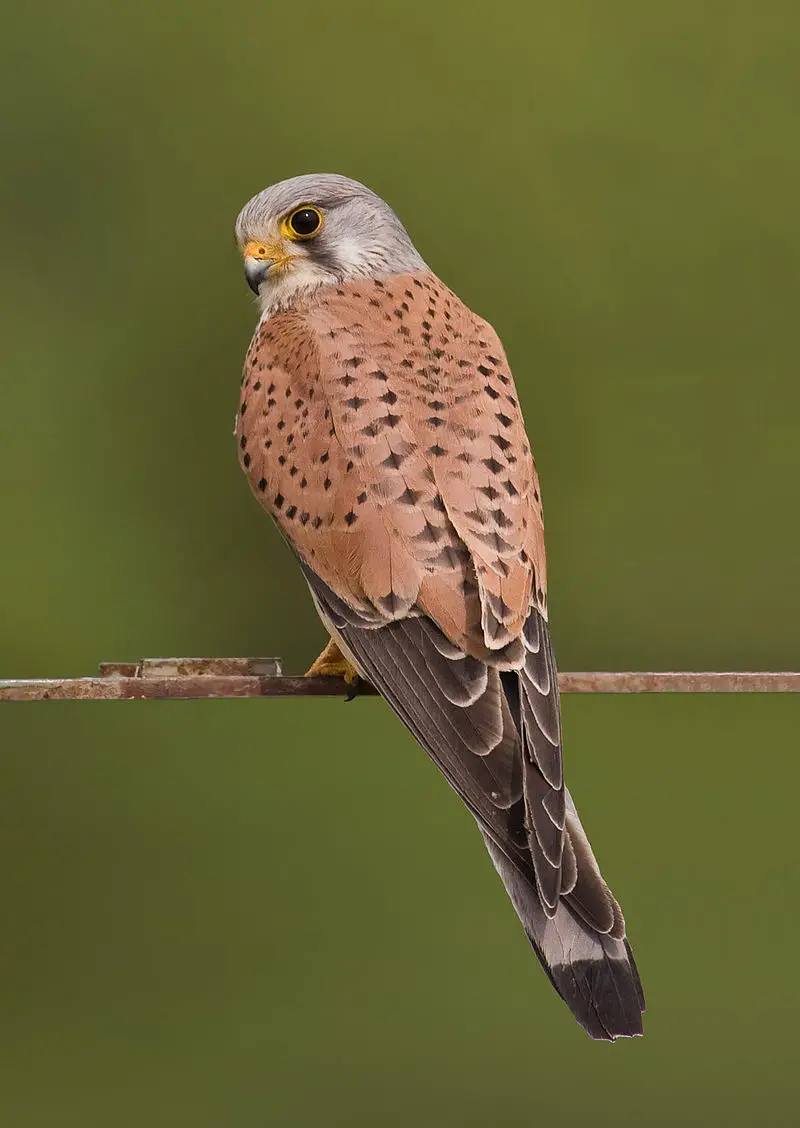
The Common Kestrel is a species of bird belonging to the kestrel group of Falconidae. It can be found in Europe, Asia and parts of Africa, though it is most commonly seen in the United Kingdom where it’s simply referred to as “Kestrel”.
This falcon has powerful talons and exceptional vision which makes them adept hunters who feed on small mammals such as voles or mice.
They are also renowned for their hovering flight – they will hover up high and scan with amazing accuracy below until they spot prey beneath them.
The beautiful plumage on this raptor varies from country to country but generally consists of shades ranging from grey-browns through chestnut reds with tawny hues around its face area.Scientific classification:
| Kingdom | Animalia |
| Phylum | Chordata |
| Class | Aves |
| Order | Falconiformes |
| Family | Falconidae |
| Genus | Falco |
| Species | F. tinnunculus |
Also Featured In: Birds of Wales: Exploring Diverse Habitats and Conservation Efforts,
35. Hornbill
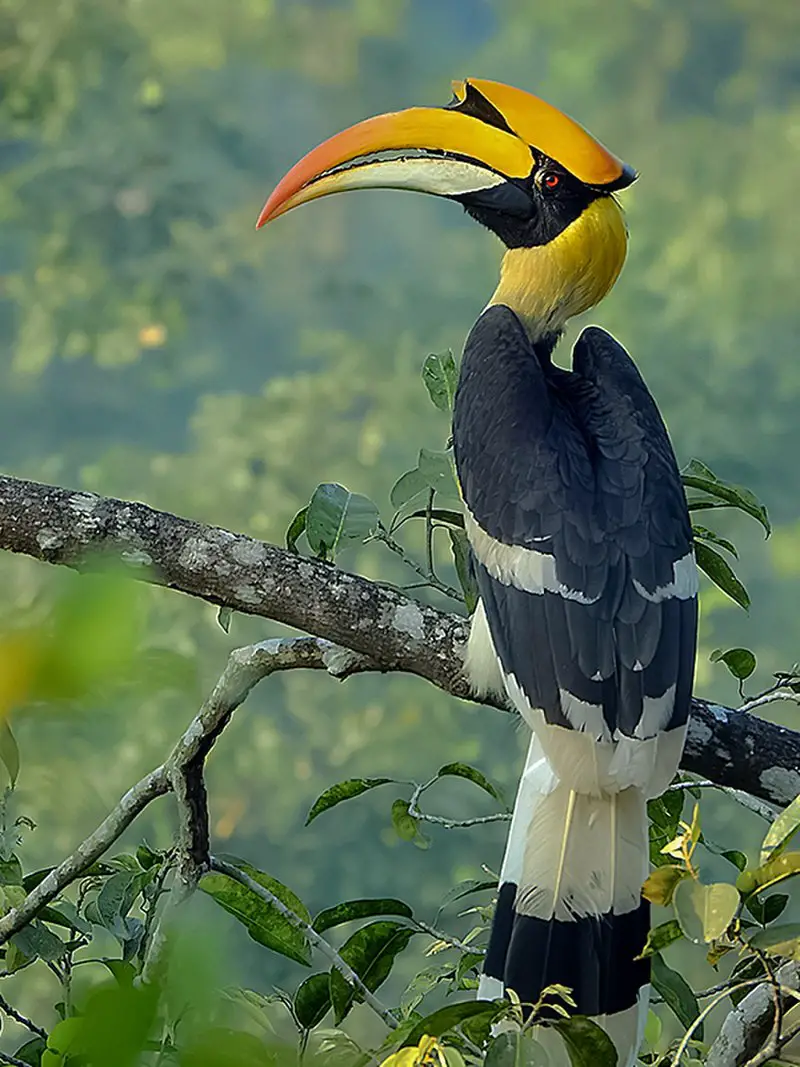
Hornbills are a tropical and subtropical bird species with characteristic long, curved bills. Their English and scientific names both refer to the shape of their bill which resembles that of a cow’s horn.
They have strong beaks for cracking open hard-shelled fruits as well as powerful wings for flying between trees or over great distances in search of food or mates.
Hornbills also feature beautiful plumage ranging from white to black feathers with yellow, brown, red and blue accents on the head, neck and back areas depending on the species.
In addition they often display brightly coloured casques – helmet like structures – atop their upper mandible adding further visual appeal to these majestic birds.Scientific classification:
| Kingdom | Animalia |
| Phylum | Chordata |
| Class | Aves |
| Order | Bucerotiformes |
| Family | Bucerotidae Rafinesque, 1815 |
Also Featured In: Birds of South African, African Birds
36. Red-Vented Bulbul
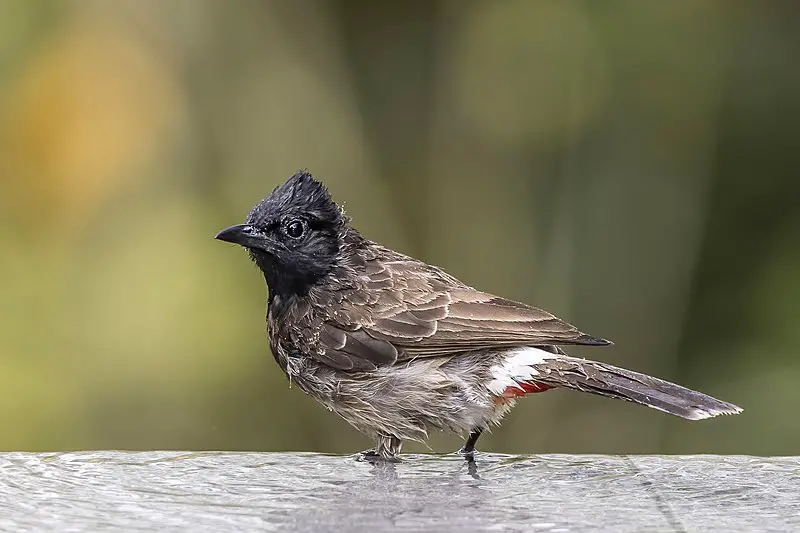
The Red-vented Bulbul is an impressive bird native to the Indian subcontinent, and has been introduced to regions around the world.
It belongs to the bulbul family of passerines and is a resident breeder in many countries including Sri Lanka, Burma, Bhutan and Nepal.
It also thrives in New Zealand, Argentina, Tonga and Fiji as well as parts of Samoa, Australia USA and Cook Islands.
This species has grey heads with white cheeks that contrast sharply against their black wings with bright red vent feathers which give them their name.
They typically live near woodland areas where they can forage for fruits or small insects on trees or bushes; this makes them useful birds for controlling insect populations naturally.
The male red-vented bulbuls are renowned songsters who sing out from treetops at dawn each day – adding some beautiful melodies to any garden.Scientific classification:
| Kingdom | Animalia |
| Phylum | Chordata |
| Class | Aves |
| Order | Passeriformes |
| Family | Pycnonotidae |
| Genus | Pycnonotus |
| Species | P. cafer |
Also Featured In: Birds of Myanmar, Birds that Live in Tahiti Island
37. Swifts
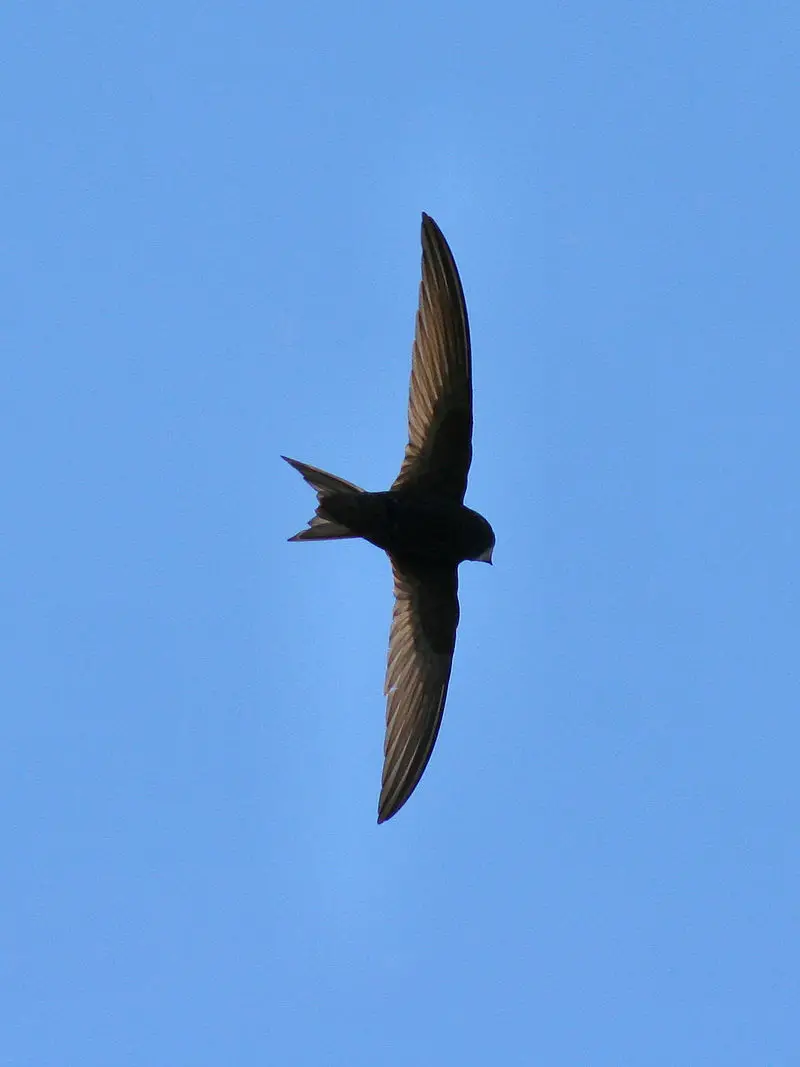
Swifts are small, aerial birds that belong to the Apodidae family. They look similar to swallows but they aren’t related in any way.
Swifts have evolved differently from other passerines and instead share an order with hummingbirds – the Apodiformes.
The Hemiprocnidae also shares a close relationship with swifts, being referred to as ‘treeswift’ due to their affinity for perching on trees rather than flying through the air like regular swifts do.
While these two species may appear quite similar at first glance, closer inspection will reveal vast differences between them which has come about over time via convergent evolution.Scientific classification:
| Kingdom | Animalia |
| Phylum | Chordata |
| Class | Aves |
| Order | Apodiformes |
| Family | Apodidae Hartert, 1897 |
Also Featured In: Common birds in Mozambique , Birds You’ll Find in Moldova
38. Rook
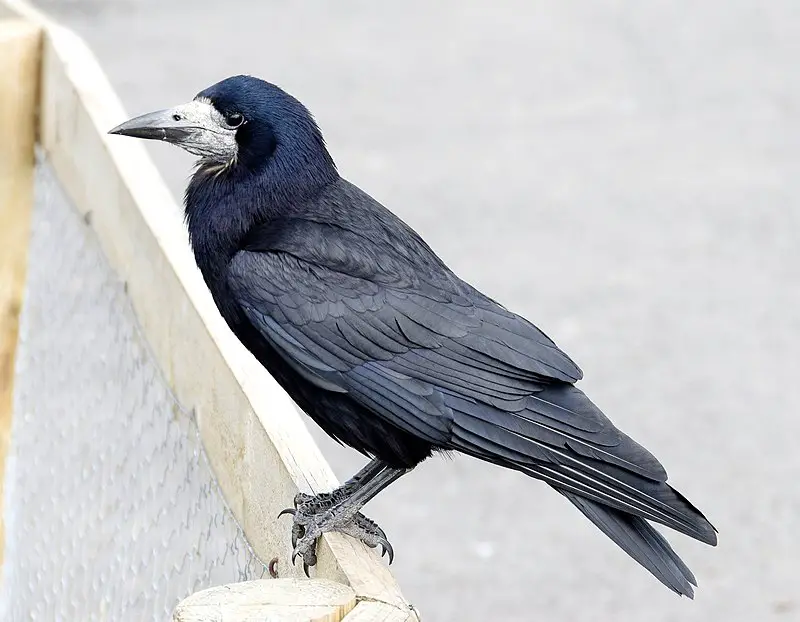
Rooks are a species of black-feathered birds found in the Palearctic region from Scandinavia to eastern Siberia. They have distinctive white, featherless areas on their faces and nest communally in tall trees.
Rooks are social creatures that often forage together for food such as insects, earthworms, seeds and small animals like mice or frogs.
They also enjoy bathing regularly in shallow pools of water and dusting themselves off afterwards with dry soil or sand.
In addition to providing protection against parasites when nesting high up in the treetops, rooks will use communal roost sites during winter nights which can contain thousands of individuals all huddled close together.Scientific classification:
| Kingdom | Animalia |
| Phylum | Chordata |
| Class | Aves |
| Order | Passeriformes |
| Family | Corvidae |
| Genus | Corvus |
| Species | C. frugilegus |
Also Featured In: Most Beautiful birds of Greece,
39. Common House Martin
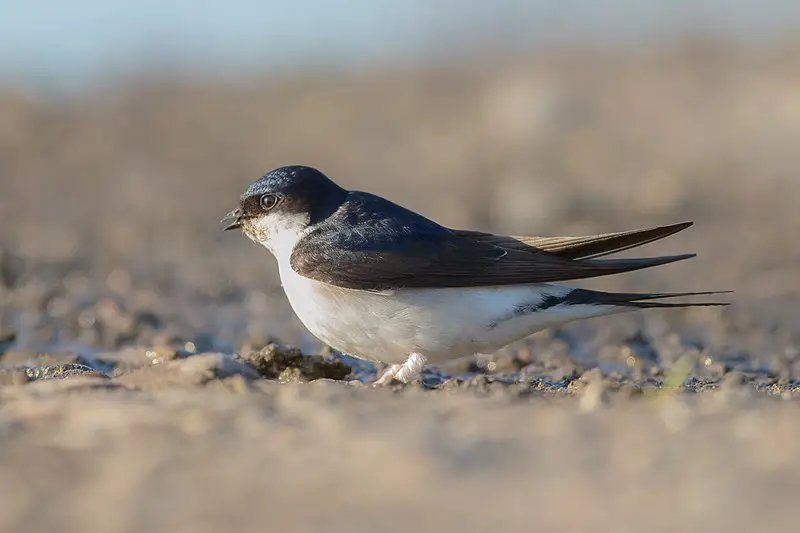
The Common House Martin is a beautiful migratory bird of the swallow family. It breeds in Europe, North Africa and across the Palearctic region, then winters in sub-Saharan Africa and tropical Asia.
This species feeds on insects caught while flying through its habitat.
Its main food source changes depending on where it is located at any given time as it follows warmer climates with more abundance of flies during winter months when migrating southward from its breeding grounds up north.
The house martin has an unmistakable appearance; they have glossy blue upperparts and white underparts that contrast beautifully against their black wingspan which can reach up to 18 cm long.Scientific classification:
| Kingdom | Animalia |
| Phylum | Chordata |
| Class | Aves |
| Order | Passeriformes |
| Family | Hirundinidae |
| Genus | Delichon |
| Species | D. urbicum |
Also Featured In: Birds that Make Mud Nests,
40. Feral Pigeon
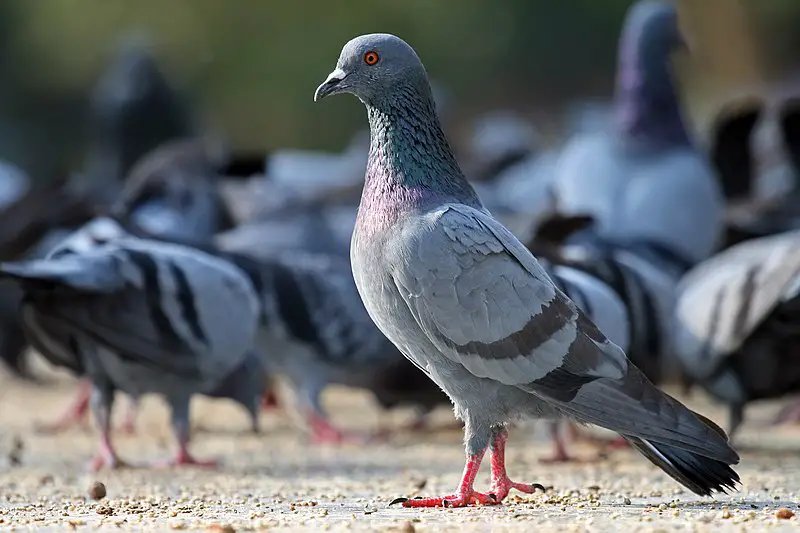
Feral pigeons are birds that have descended from the domestic pigeon, which was originally bred from its wild ancestor – the rock dove.
These urban doves can be found living in most cities and towns where they inhabit street corners and rooftops.
They thrive on a diet of seeds, grains and human food scraps with their ability to adapt well to various conditions making them successful opportunists able to survive in city environments.
Feral pigeons may appear similar but differ slightly due to unique coloration patterns or slight size differences indicating how long ago each bird’s ancestors were domesticated.
Despite being considered pests by some people these avian creatures provide us an opportunity for exploration into our own relationship with wildlife as we share space within our cities.Scientific classification:
| Kingdom | Animalia |
| Phylum | Chordata |
| Class | Aves |
| Order | Columbiformes |
| Family | Columbidae |
| Genus | Columba |
| Species | C. livia |
| Subspecies | C. l. domestica |
Also Featured In: Doves Birds,
41. Domestic Pigeon
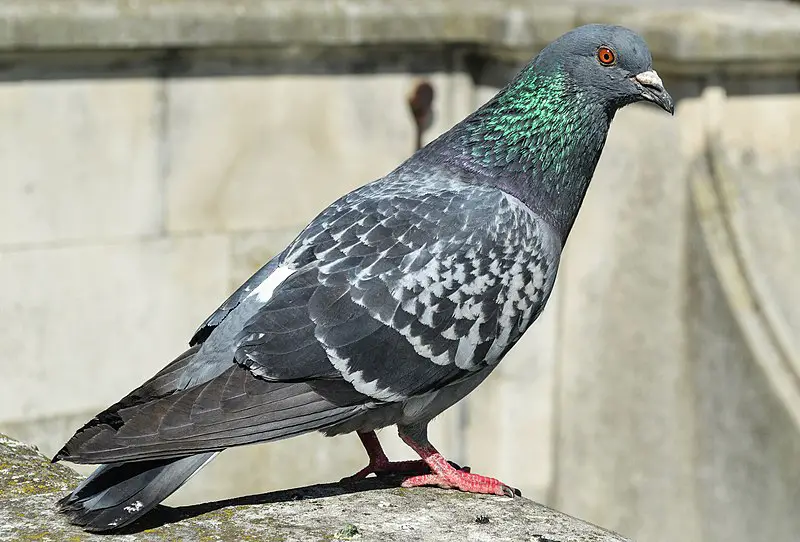
The domestic pigeon is a subspecies of the rock dove, which has been around for thousands of years.
It was first domesticated in Mesopotamia and Egypt over 5000 years ago, and since then it has become one of the most popular pet birds in the world.
They have many unique characteristics that make them stand out from other birds; they can recognize their owners’ voices, mimic sounds such as car alarms or bells ringing, perform complex tricks when trained properly and even use tools to solve puzzles.
Domestic pigeons are also renowned for their homing instinct – if released away from home they will find their way back with remarkable accuracy.
The ability to breed pairs quickly means that these beautiful creatures remain widely available today making them an ideal choice for bird lovers everywhere.Scientific classification:
| Kingdom | Animalia |
| Phylum | Chordata |
| Class | Aves |
| Order | Columbiformes |
| Family | Columbidae |
| Genus | Columba |
| Species | C. livia |
| Subspecies | C. l. domestica |
42. Swainson’s Thrush
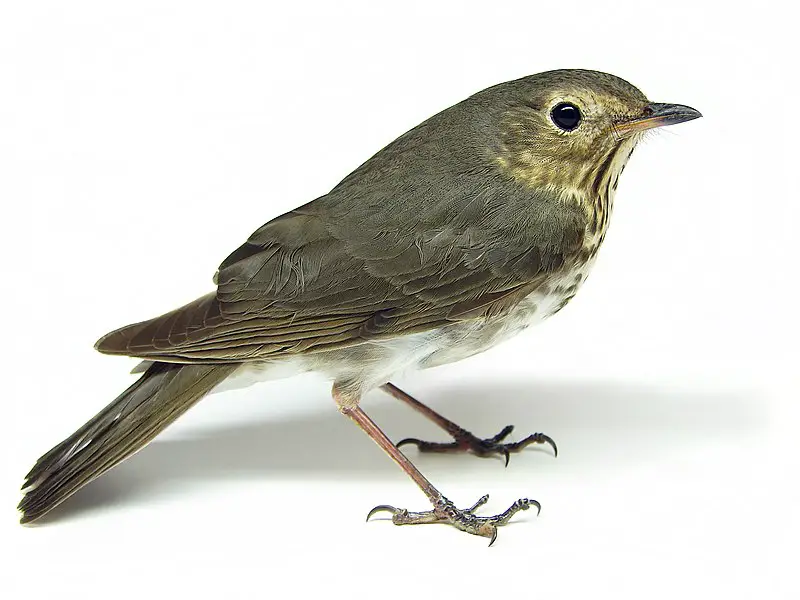
Swainson’s thrush is a medium-sized bird that belongs to the Catharus genus. Its coloration is subdued and its voice has been described as being flute-like, making it an appealing addition to any backyard.
It was named after William Swainson, an English ornithologist from the 19th century. The name of this species comes from Ancient Greek katharos which means “pure” or “clean” – appropriate for such a beautiful creature.
This type of thrush can be found throughout North America in habitats ranging from coniferous forests to open fields with scattered trees and shrubs; they also migrate south during winter months.
Despite their beauty, these birds are declining due to habitat loss and fragmentation so we must work together if we want them around forever.Scientific classification:
| Kingdom | Animalia |
| Phylum | Chordata |
| Class | Aves |
| Order | Passeriformes |
| Family | Turdidae |
| Genus | Catharus |
| Species | C. ustulatus |
Also Featured In: Thrush Species, Birds in Pacific Northwest
43. Old World Sparrows
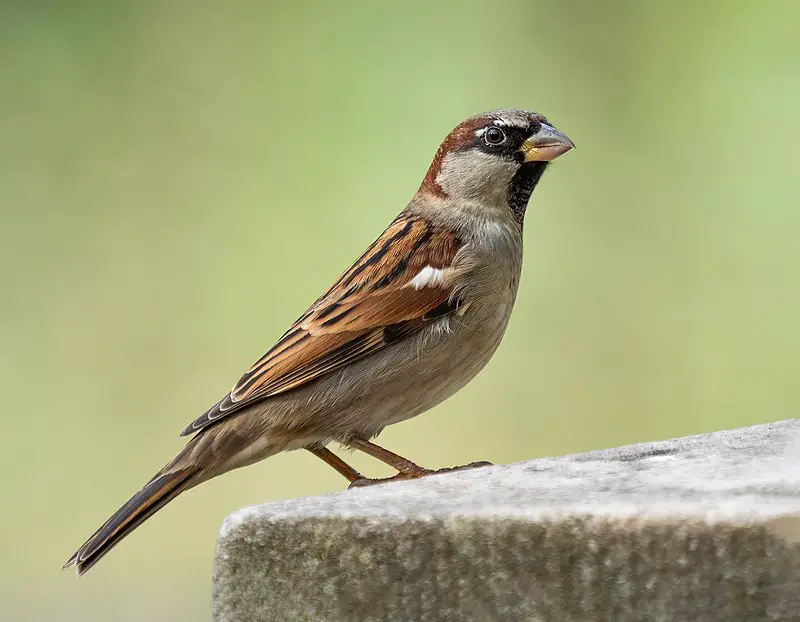
Old World sparrows are small passerine birds belonging to the family Passeridae. They are characteristically much smaller than their New World counterparts, ranging in size from 6 centimeters up to 20 centimeters depending on species.
The most common characteristics of these birds include a black or grey head and upper body with white underparts and white stripes above their eyes.
Notable features such as barring and streaking can be found across different species within this group.
Old world sparrows typically inhabit open grassland areas but have been known to nest around human dwellings near urban settings as well, making them easily recognizable by many people all over the globe.Scientific classification:
| Kingdom | Animalia |
| Phylum | Chordata |
| Class | Aves |
| Order | Passeriformes |
| Suborder | Passeri |
| Infraorder | Passerida |
| Superfamily | Passeroidea |
| Family | Passeridae Rafinesque, 1815 |
Also Featured In: Alaska Birds, Most Common Winter Birds
44. Parus
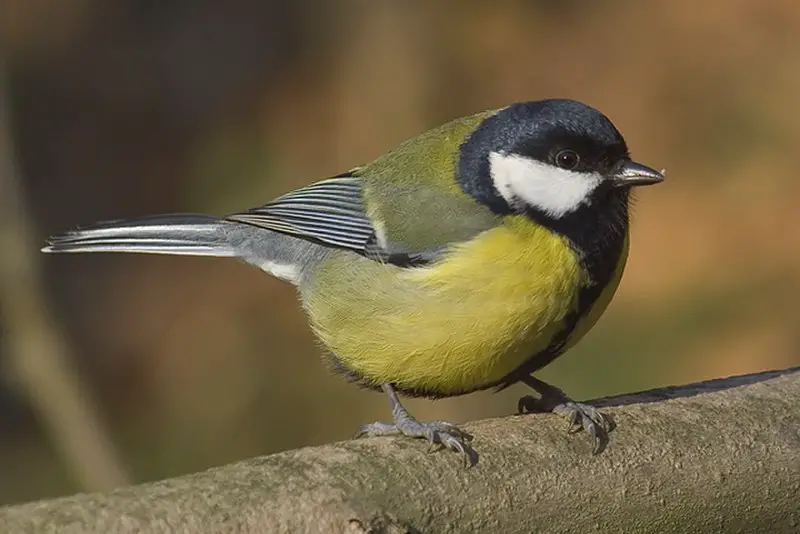
Parus is a genus of Old World birds belonging to the tit family, which was formerly much larger. Parus means “tit” in Latin and contains over 50 species.
In 2013, extensive molecular phylogenetic analysis revealed that it should be split into several new genera.
These small songbirds are mainly found in woodland habitats across Europe, Asia and Africa where they feed on insects or seeds depending on availability during different times of year.
Most have distinctive crests and black-and-white markings making them easy to identify when out birdwatching.Scientific classification:
| Kingdom | Animalia |
| Phylum | Chordata |
| Class | Aves |
| Order | Passeriformes |
| Family | Paridae |
| Genus | Parus Linnaeus, 1758 |
Also Featured In: birds of gray,
45. Long-Tailed Shrike
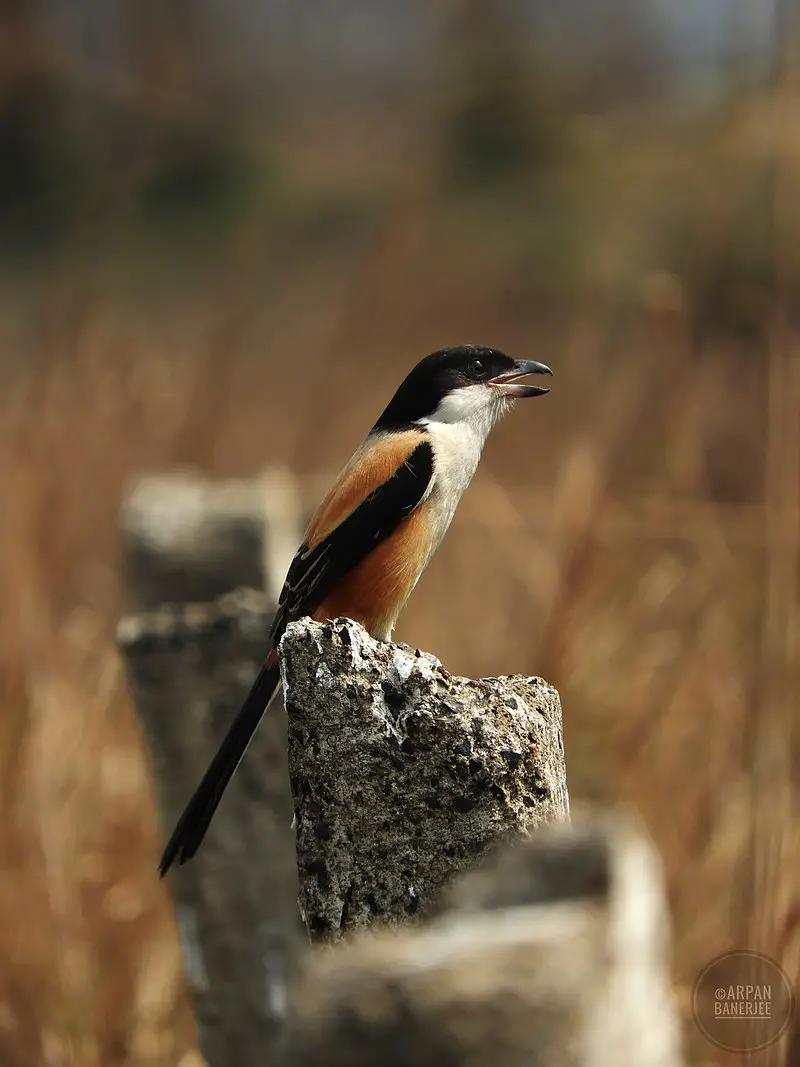
The Long-tailed shrike, also known as the rufous-backed shrike, belongs to the shrike family and is found throughout Asia.
Their appearance varies across their wide range, but they are known for their long tail and rufous-colored back.
In some areas, they are called the black-headed shrike. These birds prefer open habitats such as grasslands and farmland, where they hunt insects, lizards, and small birds
They are known for impaling their prey on thorns or barbed wire, making them easy to find.
Long-tailed shrikes are territorial and often seen perched on a high vantage point, scanning their surroundings for prey or intruders.
They are adaptable to human-made environments and have even been seen in cities. Despite their widespread range, their population is decreasing due to habitat loss and fragmentation.Scientific classification:
| Kingdom | Animalia |
| Phylum | Chordata |
| Class | Aves |
| Order | Passeriformes |
| Family | Laniidae |
| Genus | Lanius |
| Species | L. schach |
Also Featured In: Birds That Live in the Jungle, Common Birds of Maharashtra
46. Western Jackdaw

The Western Jackdaw is a member of the crow family and is found throughout Europe, western Asia, and North Africa. While most populations are resident, some migrate south in the winter.
There are four subspecies, each with distinct plumage coloration. Despite being a common bird, the Western Jackdaw is a fascinating species known for its high intelligence and adaptability.
These birds have been observed using tools, working collaboratively to solve problems, and even recognizing individual human faces.
With their distinctive and varied calls, they are often heard before they are seen, chattering away in the trees or on rooftops.
Due to their remarkable intelligence and adaptability, the Western Jackdaw is widely regarded as a beloved symbol of wildlife in many cultures.Scientific classification:
| Kingdom | Animalia |
| Phylum | Chordata |
| Class | Aves |
| Order | Passeriformes |
| Family | Corvidae |
| Genus | Coloeus |
| Species | C. monedula |
Also Featured In: Flocks Birds around Us, Ukrainian Birds You Should Know
47. Northern Flicker

The Northern flicker is a woodpecker species found in North America, Central America, Cuba, and the Cayman Islands. This medium-sized bird is known for its unique migration behavior.
Over 100 common names are used to refer to the Northern flicker, one of them being “yellowhammer”. It is a beautiful bird with distinctive markings and a colorful plumage.
The Northern flicker is an important species in its ecosystem and plays a key role in maintaining a healthy balance in the environment.
Despite being a woodpecker, the Northern flicker has a diverse diet that includes insects, fruits, and seeds.
It is fascinating to observe this bird as it pecks at trees in search of food, communicates with its unique vocalizations and performs its incredible aerial displays.
The Northern flicker is truly a remarkable bird species that is worthy of our admiration and protection.Scientific classification:
| Kingdom | Animalia |
| Phylum | Chordata |
| Class | Aves |
| Order | Piciformes |
| Family | Picidae |
| Genus | Colaptes |
| Species | C. auratus |
Also Featured In: Birds That Live in Colorado, Birds Commonly Found in New York
48. Eurasian Magpie
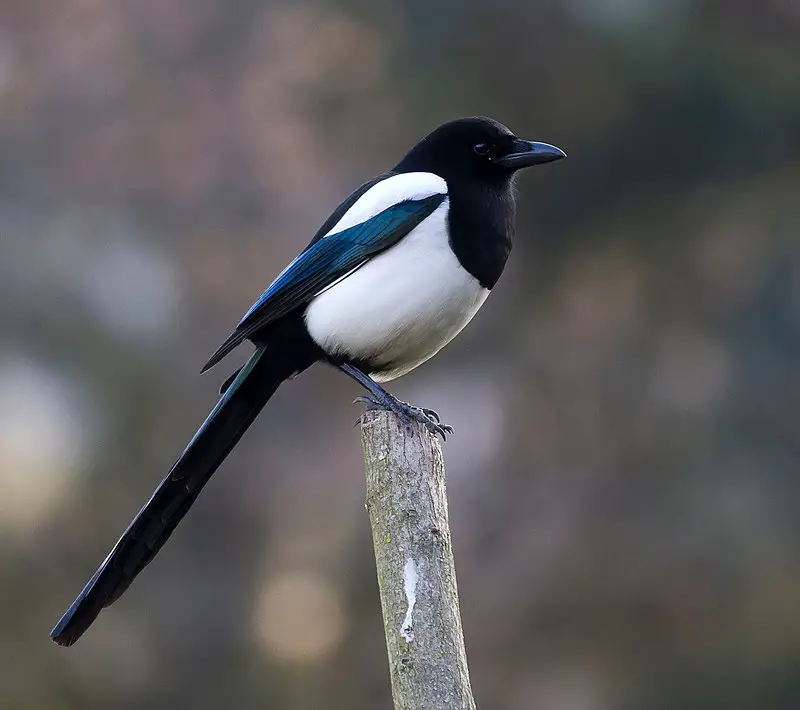
The Eurasian magpie, also known as the common magpie, is a bird found in the northern part of the Eurasian continent. It belongs to the corvids family and is part of the “monochrome” magpies.
The bird is a resident breeder that is always available in Europe. The only other magpie found in Europe is the Iberian magpie.
The magpie is often used as a synonym for the Eurasian magpie by English speakers.
The bird has a distinct black and white appearance and is known for its intelligent behavior. It can imitate sounds heard in its environment and also demonstrates self-awareness.
The Eurasian magpie is omnivorous and feeds on insects, small mammals, and fruits.
It forms monogamous pairs that last for a lifetime and builds nests in trees or bushes. The bird is not endangered and is often regarded as a nuisance due to its habit of raiding gardens for food.Scientific classification:
| Kingdom | Animalia |
| Phylum | Chordata |
| Class | Aves |
| Order | Passeriformes |
| Family | Corvidae |
| Genus | Pica |
| Species | P. pica |
Also Featured In: Common Estonian Birds, European Birds
49. Milvus
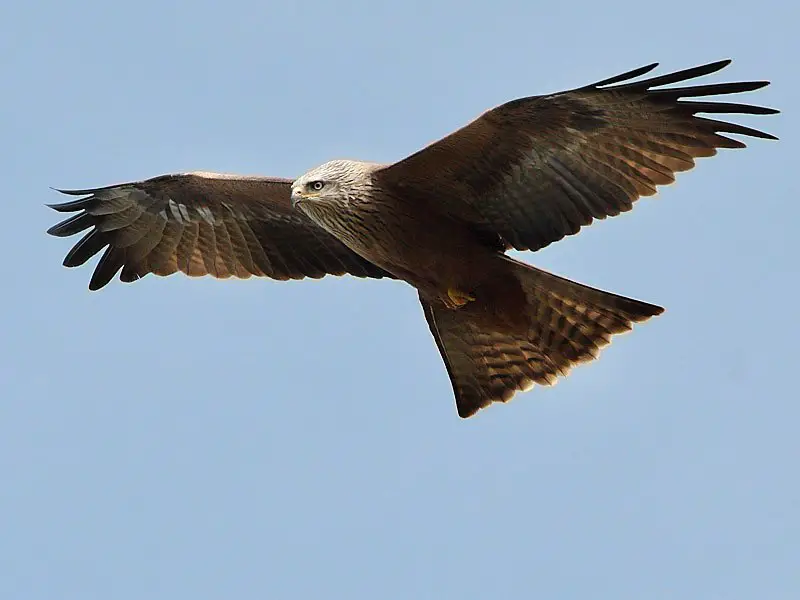
The Milvus genus is comprised of medium-sized birds of prey, with the red kite being the type species. This group is part of the subfamily Milvinae and contains three species.
The name Milvus is derived from the Latin word for the red kite. According to allozyme data, both black and red kites have significant genetic diversity.
These birds are found primarily in the Old World and are known for their hunting abilities.
Overall, the Milvus genus is a fascinating group of birds that play an important role in their respective ecosystems.Scientific classification:
| Kingdom | Animalia |
| Phylum | Chordata |
| Class | Aves |
| Order | Accipitriformes |
| Family | Accipitridae |
| Subfamily | Milvinae |
| Genus | Milvus Lacépède, 1799 |
Also Featured In: Common Carnivore Birds,
50. Great Herons
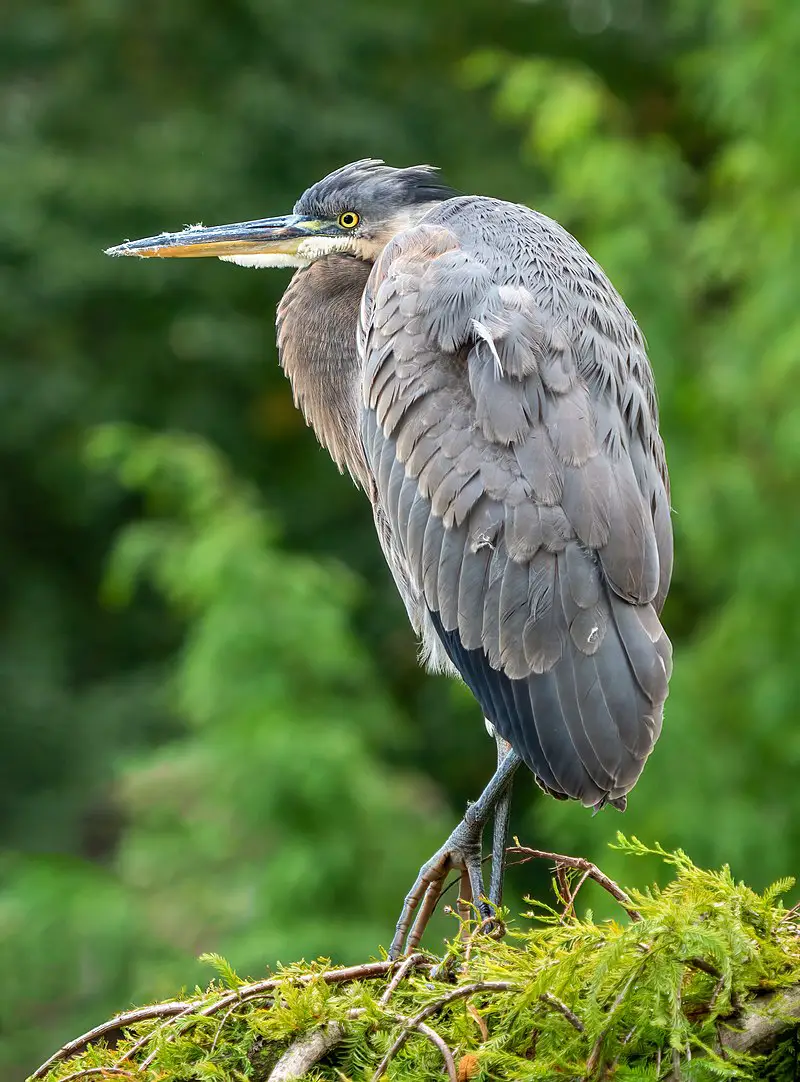
Great herons are a part of the Ardea genus of herons. They are known for their large size, typically measuring 80-100 cm in length. These birds can be found in wetlands where they hunt for fish, frogs, and other aquatic prey.
Great herons are known to breed in colonies in trees, building large stick nests for their young. Unlike some other heron species, great herons may migrate south during the winter months.
With their impressive size and stunning plumage, great herons are a beloved sight for birdwatchers and nature enthusiasts alike.Scientific classification:
| Kingdom | Animalia |
| Phylum | Chordata |
| Class | Aves |
| Order | Pelecaniformes |
| Family | Ardeidae |
| Subfamily | Ardeinae |
| Genus | Ardea Linnaeus, 1758 |
Also Featured In: Swamps Birds You Should Know,